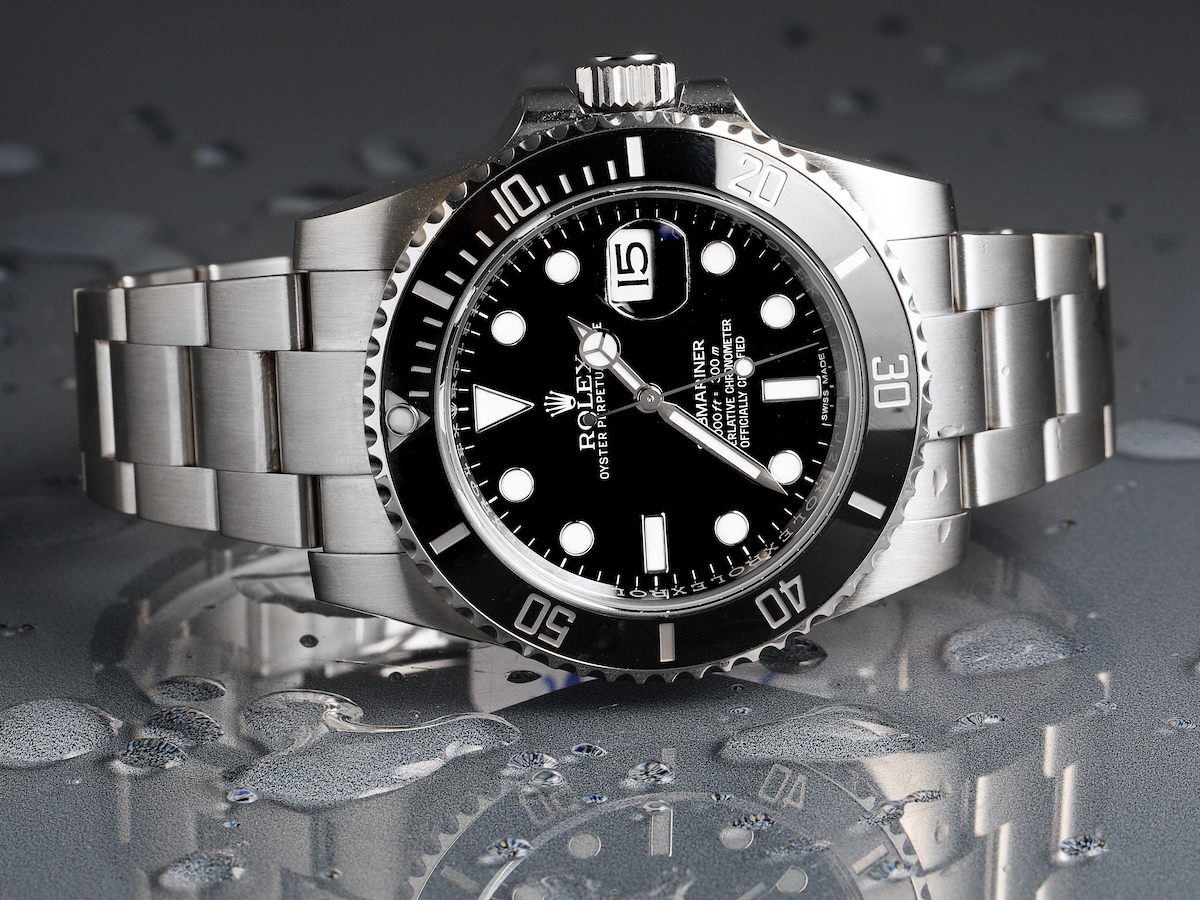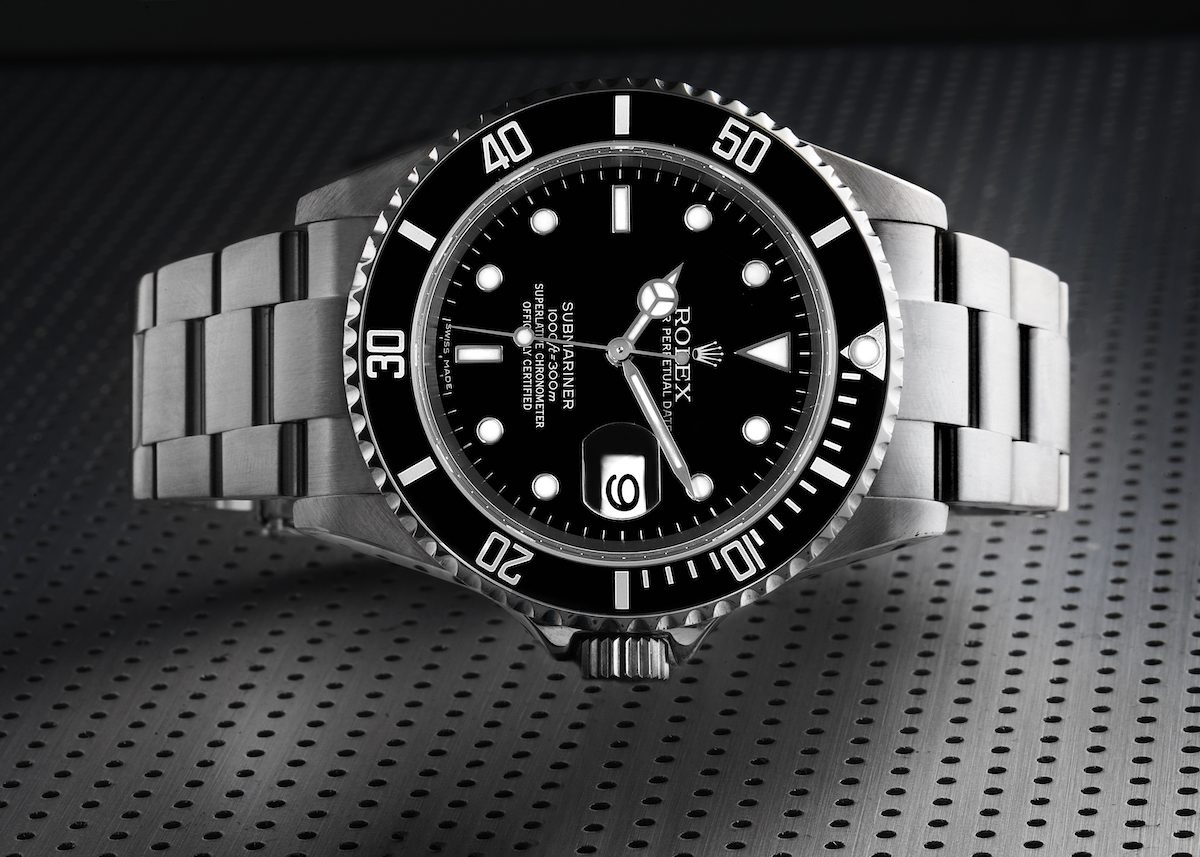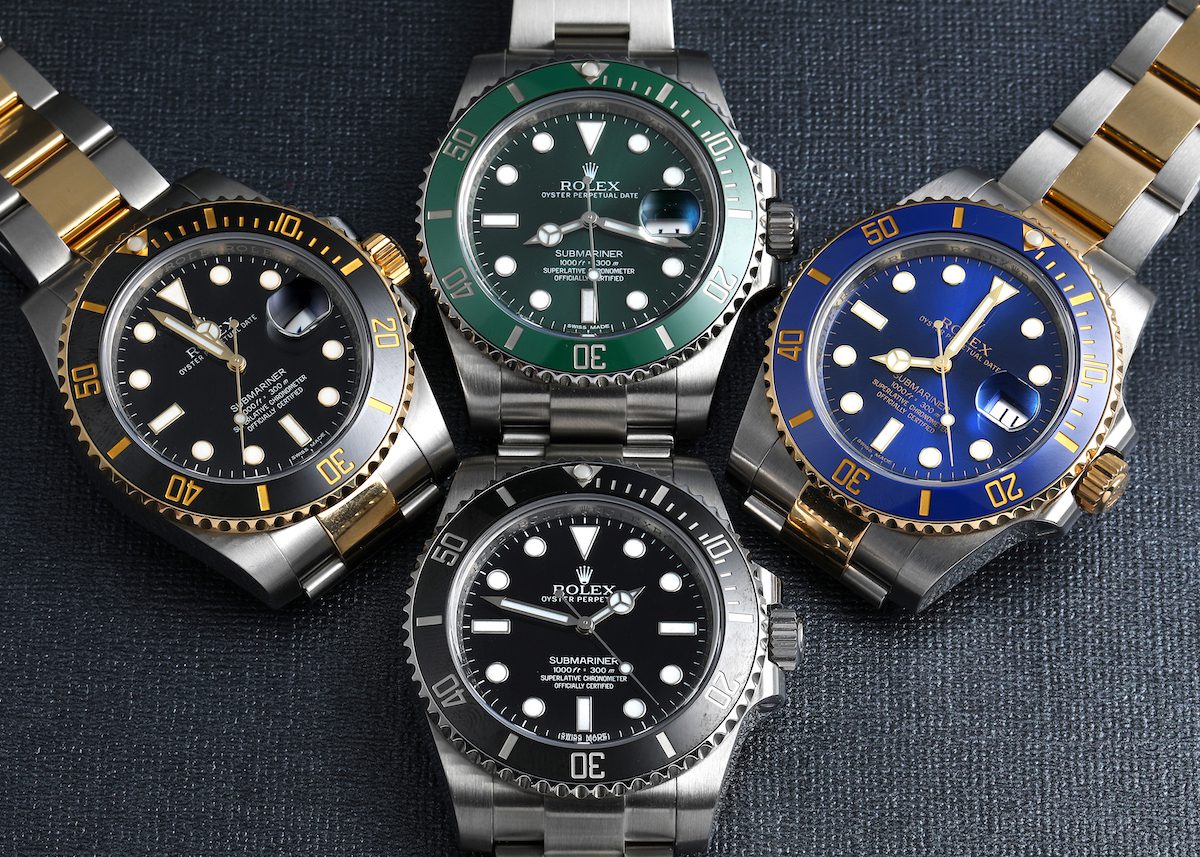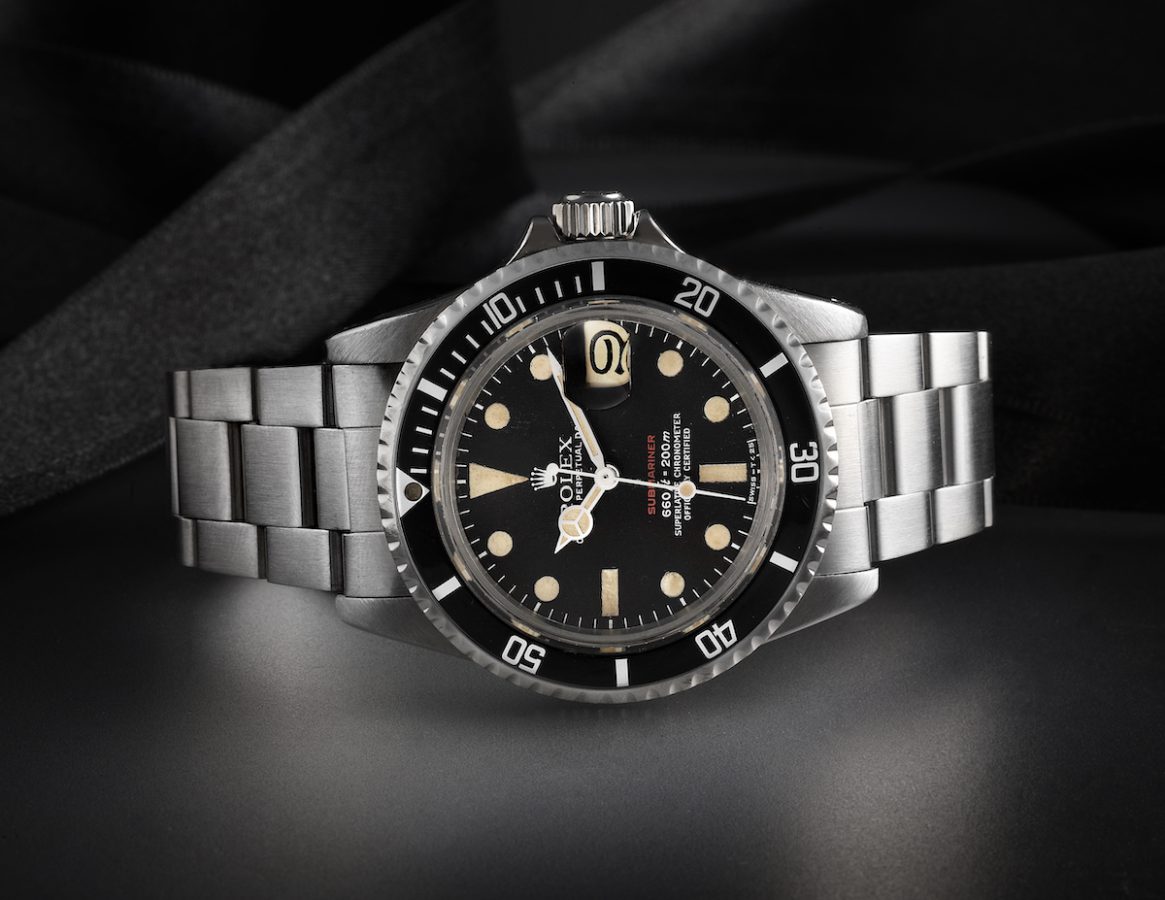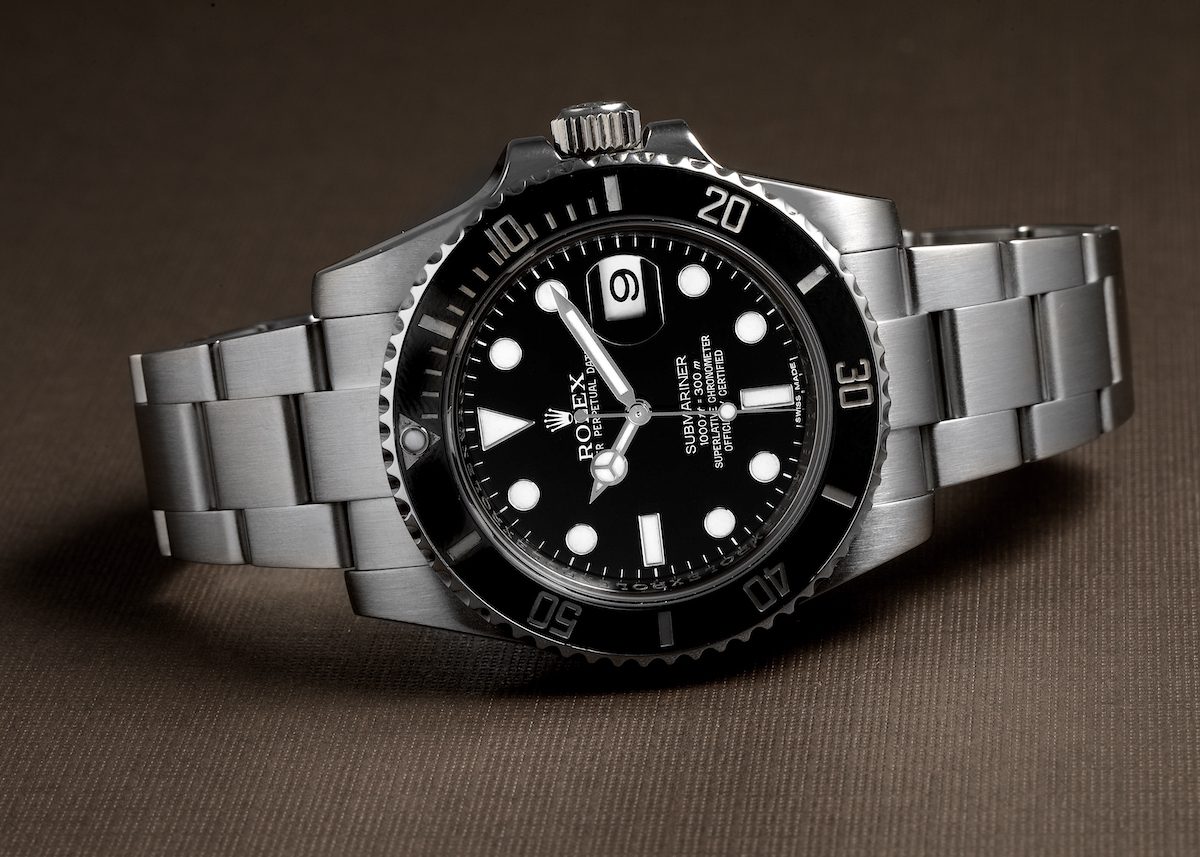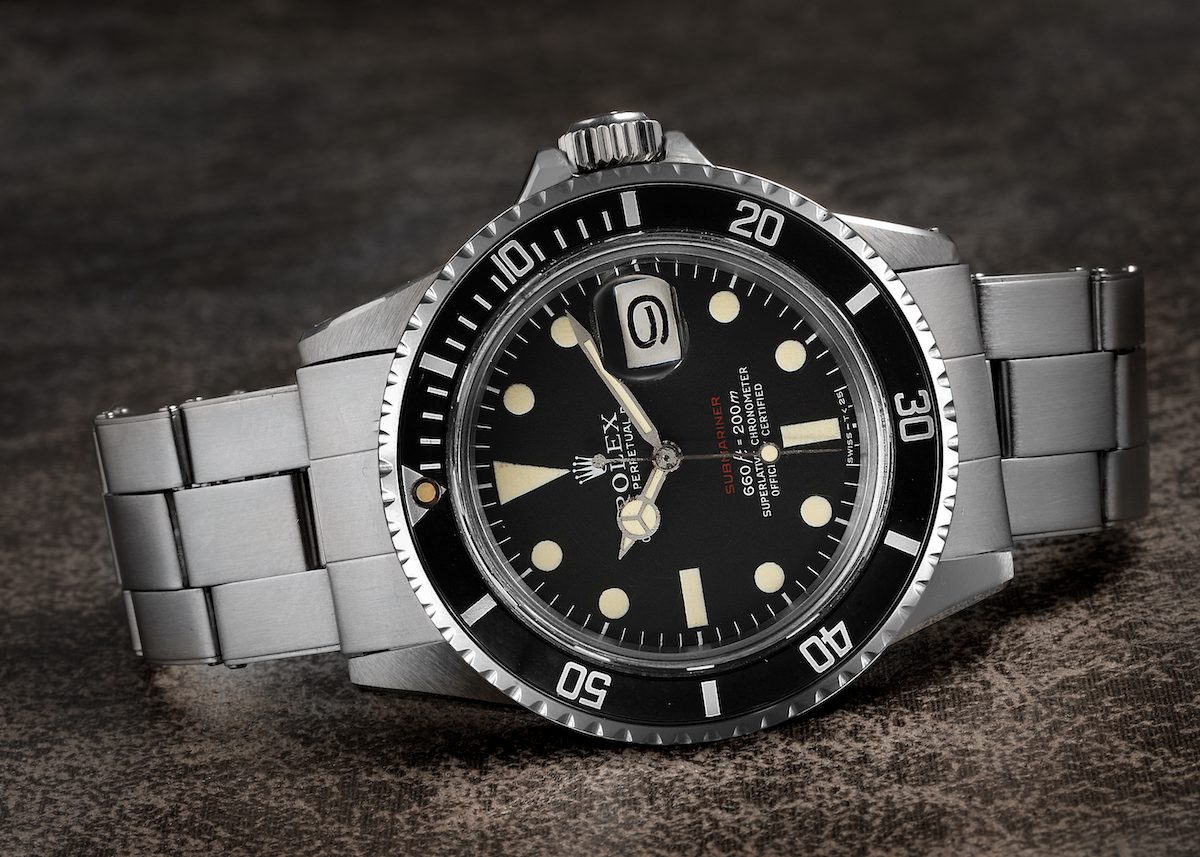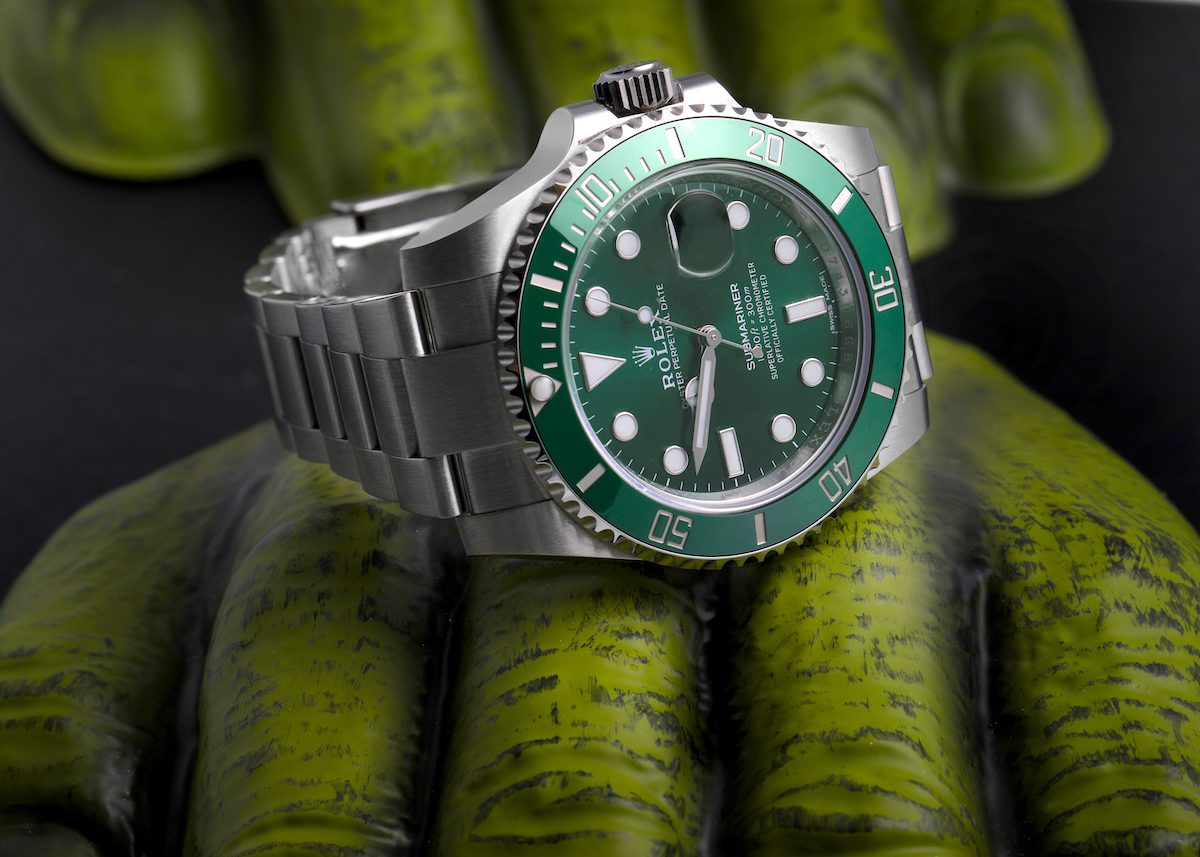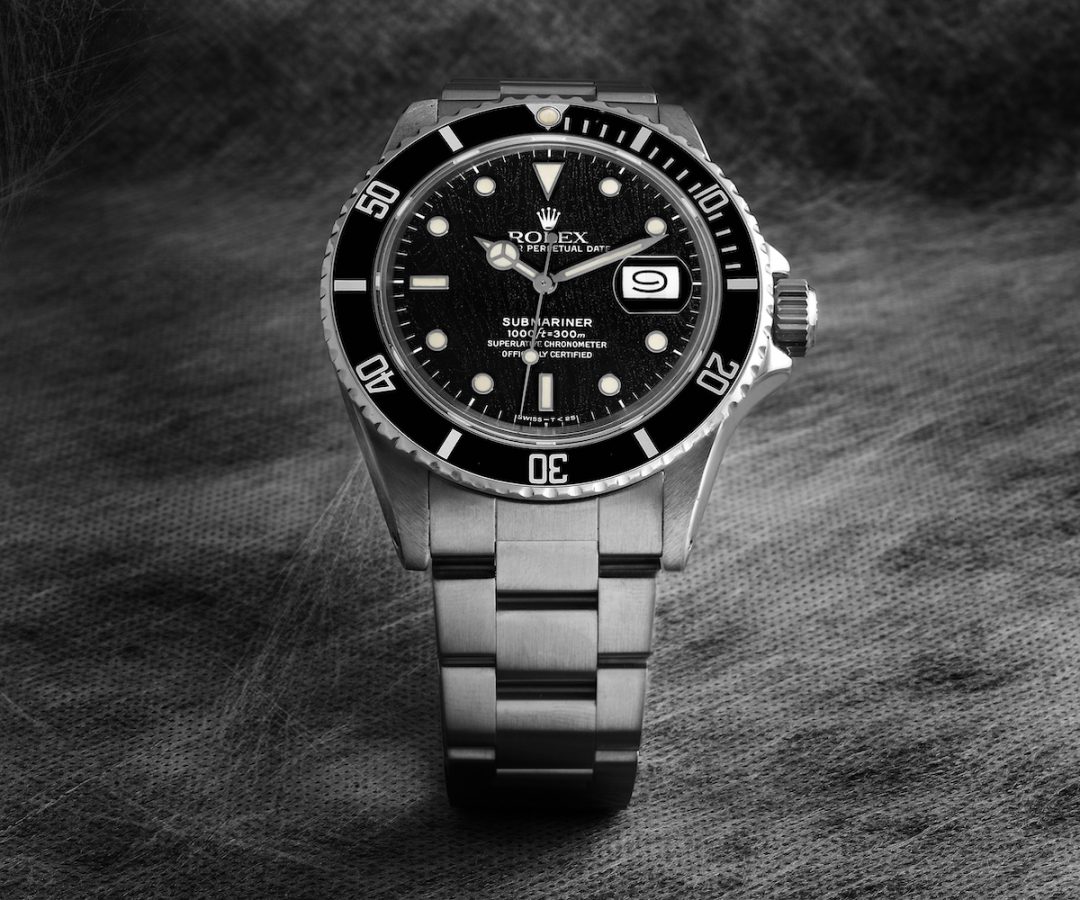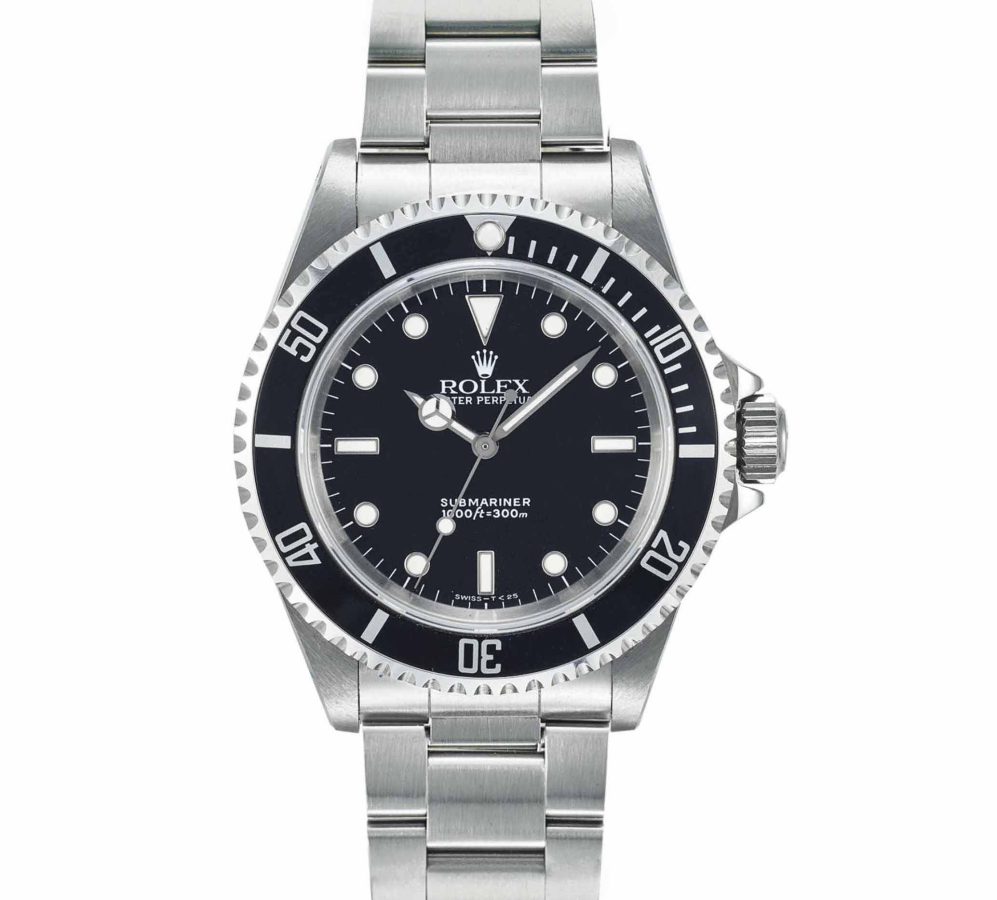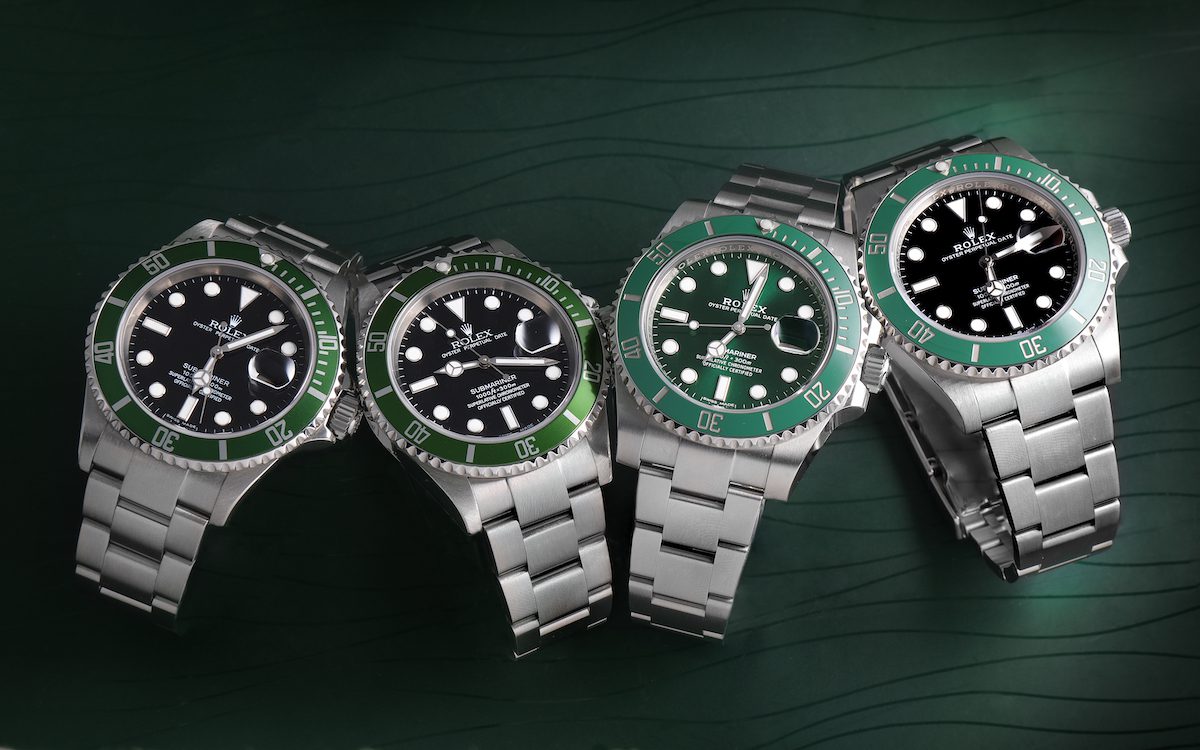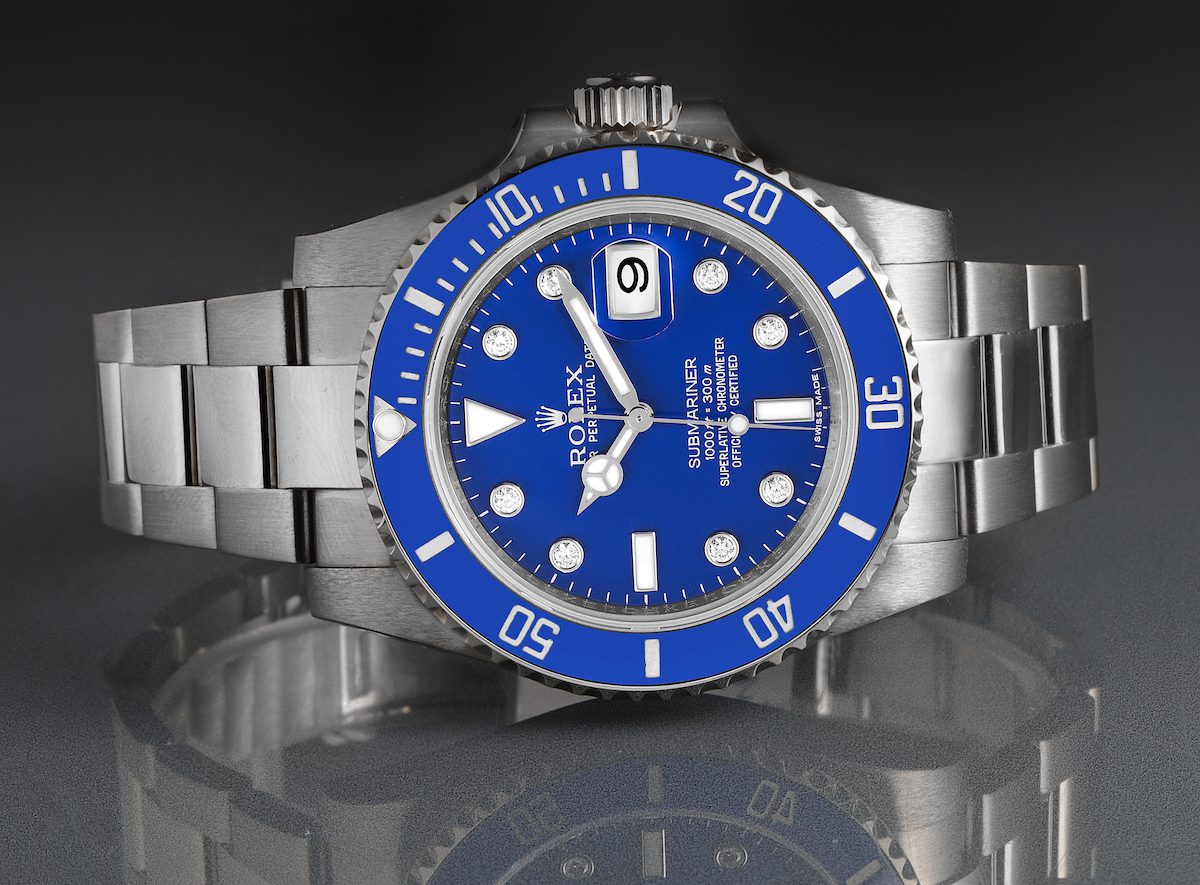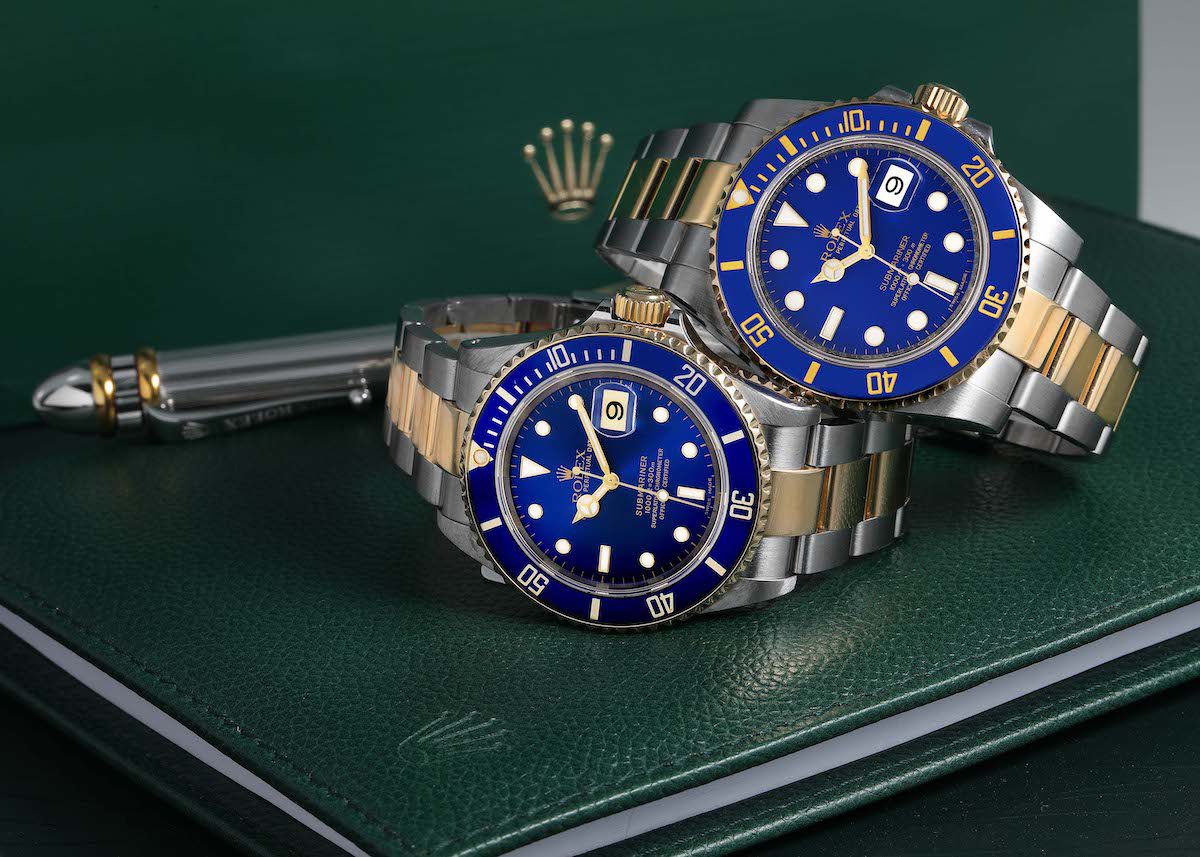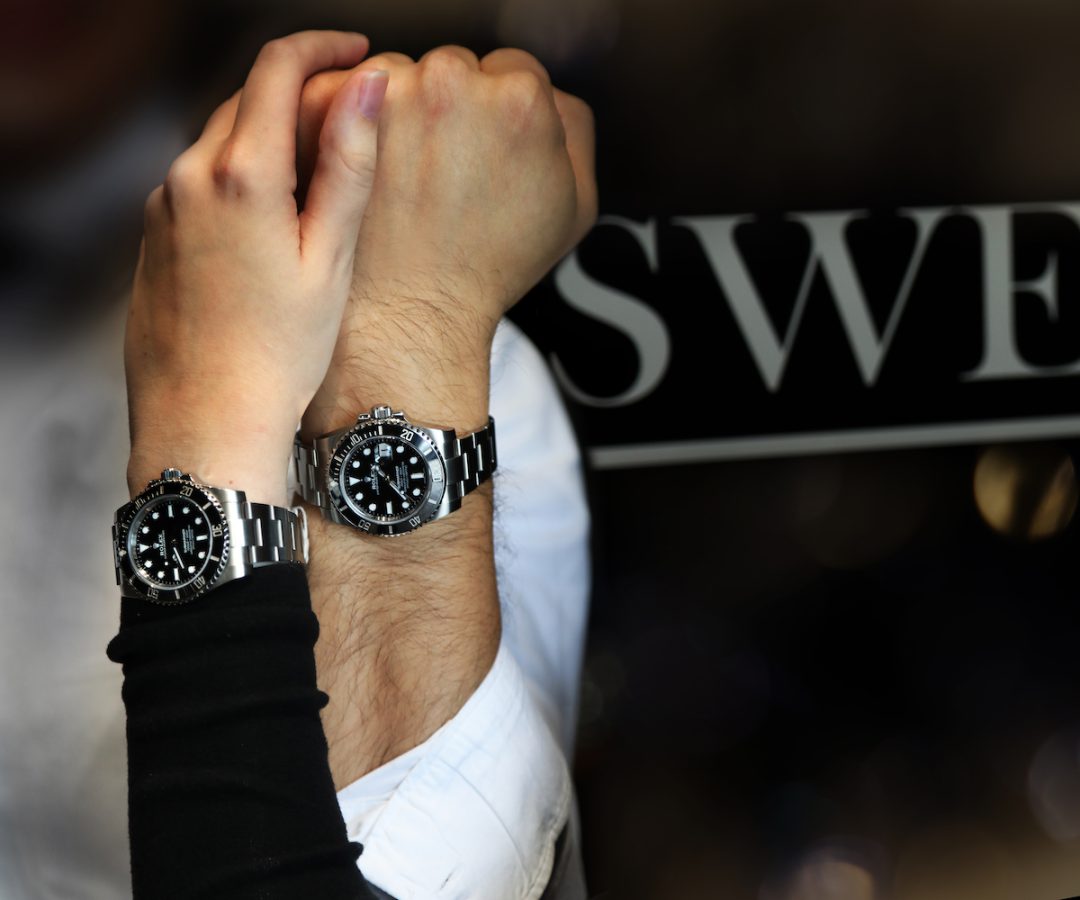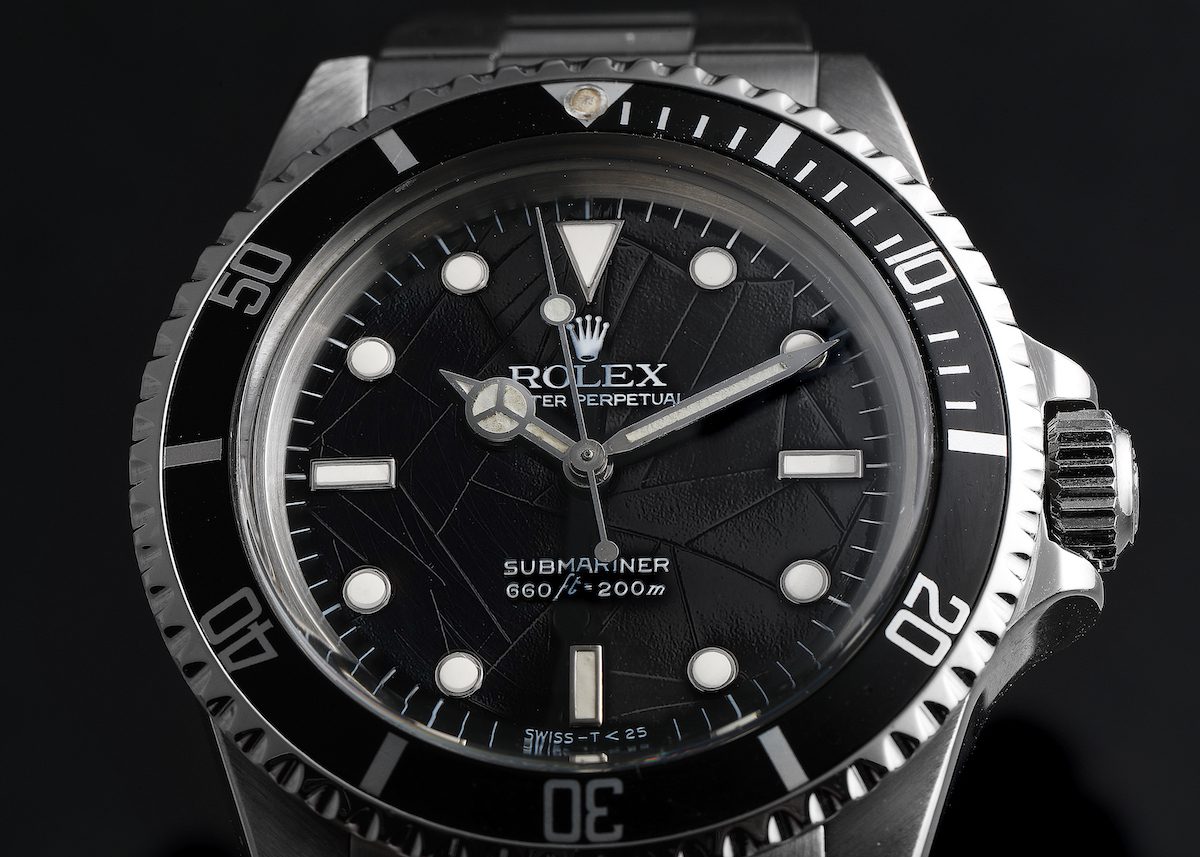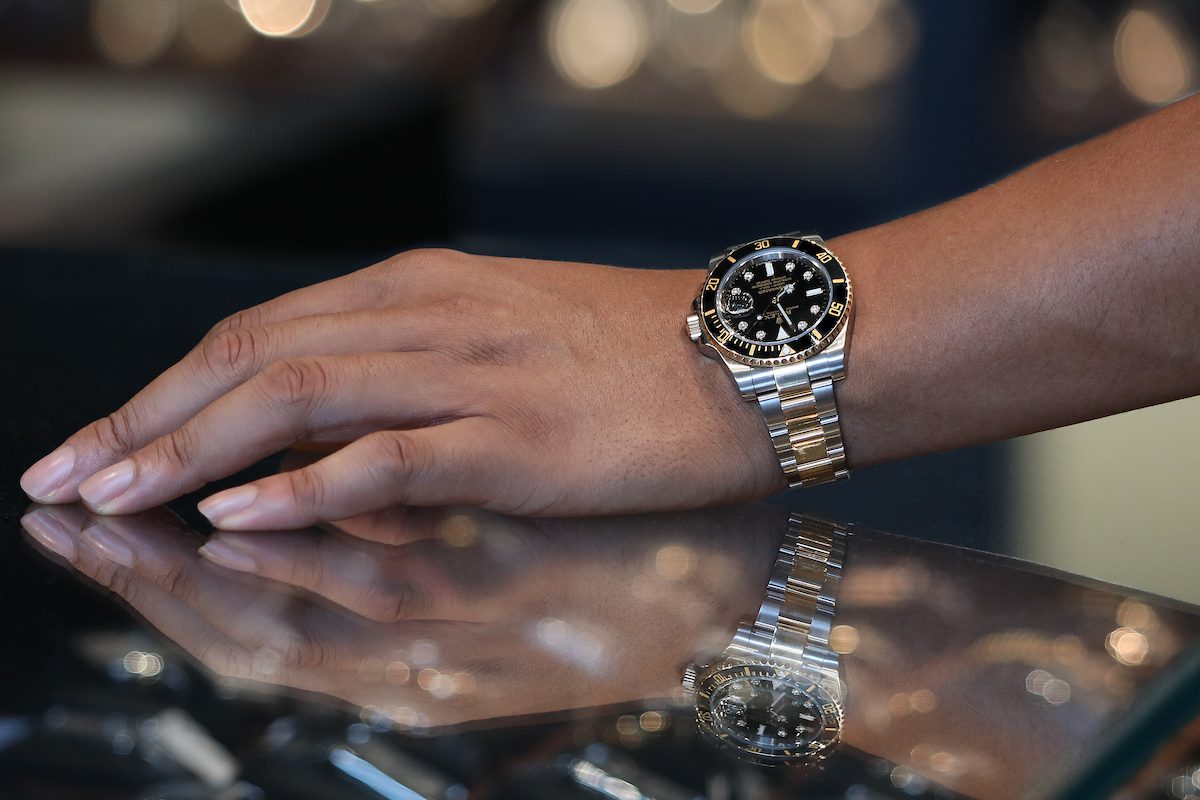The Rolex Submariner is considered the watch to own. While it was originally created for divers, its combination of high functionality and striking yet timeless design has earned fans beyond the sport. In fact, it can be reasonably described with various superlatives – it is the most important, most recognized, most emulated, and most iconic sports watch of all time.
The original tool watch design of the Submariner was fashioned in stainless steel, but its specs, materials, and features have become available in a wide variety of metals and colorways – all while keeping the fundamental design intact.
Its classic design makes the Rolex Submariner suitable for any occasion and will all kinds of ensembles, from jeans to suit and tie. The Rolex Submariner turns 70 this year, and it’s still one of Rolex’s most popular models, and a pop culture symbol in its own right.
Ready to add a Rolex Submariner to your collection? Let’s take a deep dive into the history of the Rolex Submariner, and the different options available to you, with SwissWatchExpo’s Ultimate Guide to the Rolex Submariner.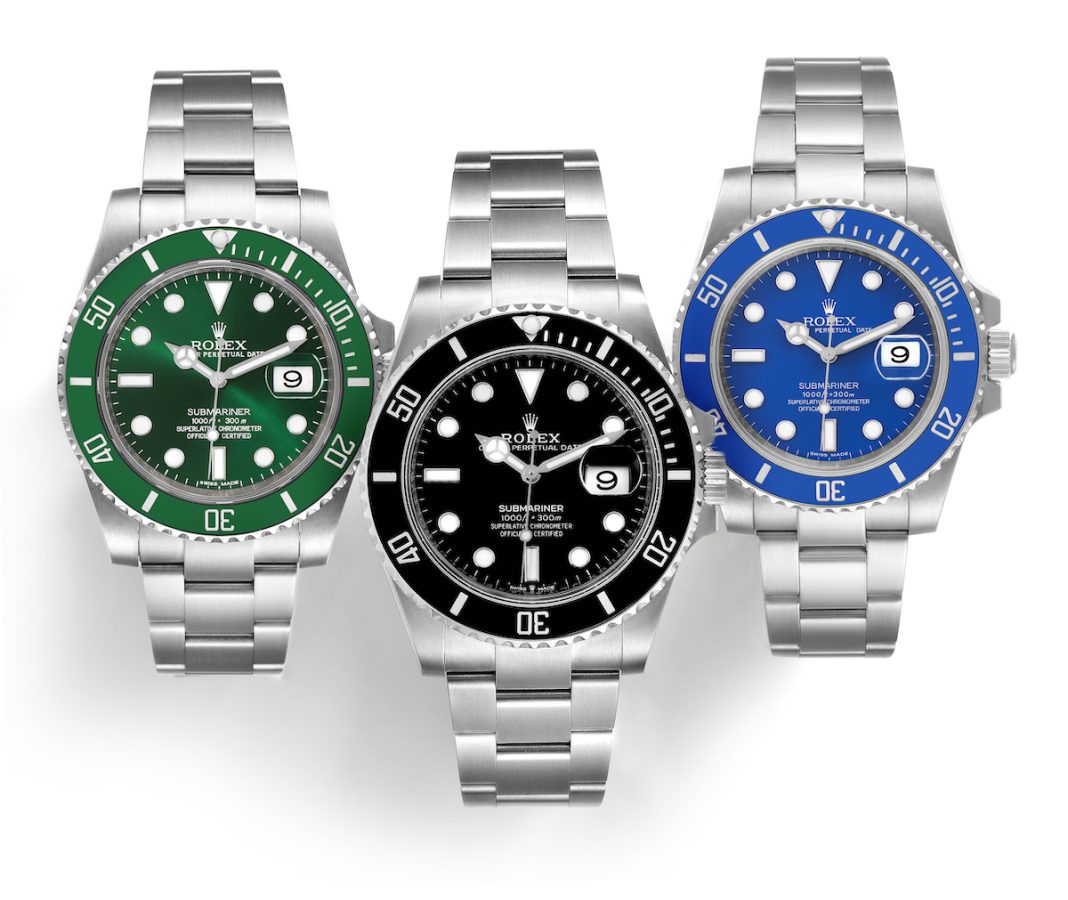
Rolex Submariner Hulk, Steel Black Dial, and Smurf
A Brief History of the Rolex Submariner
Given the popularity and long history of the Rolex Submariner, you could be forgiven for thinking it was the very first dive watch Rolex ever made, but it wasn’t.
As far back as 1926, Rolex had already created the world’s first water-resistant and dust-proof timepiece, aptly named the Oyster. The origin of its name is rather straightforward – Rolex founder Hans Wilsdorf was said to be having oysters at a dinner party, and was inspired by the hard to open shells of the mollusks. He realized it would be the perfect name for the tightly sealed case they were working on. Thus, the Oyster watch was born, and the name “Oyster” would forever be associated with Rolex.
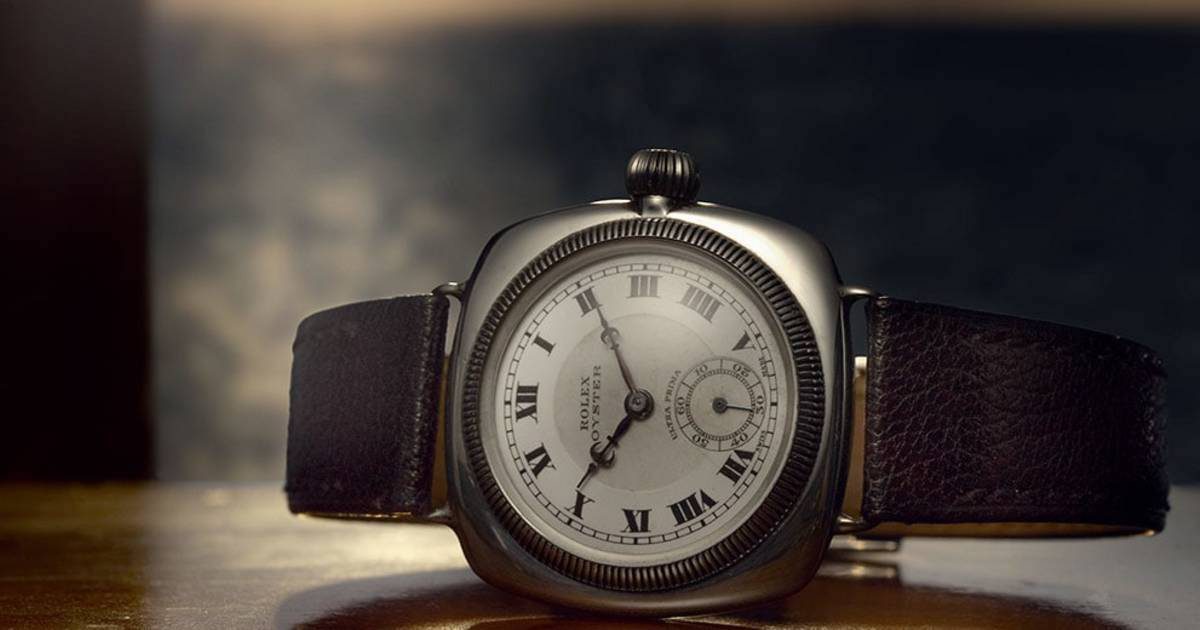
The Rolex Oyster paved the way for water-resistant watches (photo: Rolex)
Hans was bent on creating a means to protect the delicate watch movement from water and dust. The solution they came up with was a hermetical seal – one that screws down the bezel and the case back against the middle case to create a water tight enclosure.
In November 1927, a young British secretary named Mercedes Gleitze would help prove the abilities of the Oyster watch. To pursue a long-distance swimming career, Mercedes attempted to become the first woman to swim the English channel. Her swims were extensively covered by media back then, and when she successfully crossed the channel for her sixth attempt, she had with her an Oyster watch. The watch was in perfect working order at the end of the 15 hour-15 minute swim, proving its extraordinary water resistance.
Following the launch of the Oyster, it became Rolex’s ethos to create reliable timepieces for man’s every pursuit. Beginning in the 1950s, the brand introduced a range of “tool” watches, designed not only to tell time, but to accompany its wearer even in the most extreme conditions.
Every modern dive watch has been influenced by the Rolex Submariner.
In photo: Rolex Submariner Steel Watch 16610
In quick succession, Rolex unveiled what would be their most iconic timepieces – the Turn-o-Graph, the Datejust, the Explorer, the Milgauss, the GMT-Master, and the Day-Date – names that are immediately recognizable even today.
As professional deep-sea diving and scientific exploration of the seas began to flourish, the company created a diving watch that was not just waterproof, but also elegant enough to be worn every day – the Rolex Submariner. Even 70 years on, it is still undoubtedly Rolex’s greatest triumph.
About every dive watch in the market has been influenced by the Rolex Submariner’s design, making it the undisputed reference of all diver’s watches.
Here are key milestones in the history of the Rolex Submariner.
1926: Rolex creates the world’s first waterproof and dustproof watch called the Oyster.
1930s: Rolex develops machinery to test the waterproofness of their watches.
1940s: Scuba diving begins to gain popularity as a sport.
1953: Rolex introduces the Submariner. The professional diver’s watch was equipped with an automatic movement, and a water resistance of 100 meters (330 feet) – the first diving watch to achieve this depth rating.
1959: Rolex increases the 37mm case size to 40mm, and crown guards were added. The Rolex Submariner will remain the same size until 2020.
1962: James Bond wears a Rolex Submariner. Sean Connery was the first ever actor to play Agent 007 in the film Dr.No. He wore a ref 6538 “Big Crown” Rolex Submariner, which has become more popularly known as the James Bond Submariner. The Sub would appear in different movies of the franchise until 1989.
1967: The Rolex Submariner sees a number of design changes, such as the change from radium to tritium luminescence, and variations of matte dials with black text and gilt gloss dials.
1969: Rolex introduces the date complication, which is displayed through an aperture at 3 o’ clock. The first gold Submariner is also introduced. It was at this point that the Rolex Submariner began its transition from a utilitarian timepiece to a status symbol.
1979: Three innovations were introduced that we still see in the Rolex Submariner line today: the switch from acrylic crystal to scratch-resistant sapphire crystals; from bidirectional to unidirectional rotating bezels; and lastly, improved water resistance to 300 meters (1,000 feet) from 100 meters.
1984: Rolex replaces the Submariner’s matte dials to gloss dials with white gold markers. They also launch the first two-tone (steel and gold) Submariner model.
1988: The Rolex Submariner’s construction is changed from standard 316L to stronger 904L stainless steel. It is also fitted with the Caliber 3135, largely considered as one of Rolex’s best movements.
2003: Now set firmly as the most popular and iconic dive watch, Rolex celebrates the Submariner’s 50th anniversary. To celebrate this milestone, they introduce the first Rolex Submariner with a green bezel – the “Kermit” 16610LV. This was also the first time that the color green was used on any of their dive watches. The new color was introduced along with the Super Case and Maxi Dial design which gives the Submariner more presence on the wrist. The Kermit will be followed by two more green Submariners – the Hulk 116610LV (2010) and the Starbucks 126610LV (2021).
2010: The patented Cerachrom bezel is introduced to the Submariner Date with the launch of the Rolex “Hulk” 116610LV. It is also the first time that a Submariner model is given a green dial and green bezel.
2012: The Rolex Submariner Non-Date is upgraded with the Cerachrom bezel.
2020: A new range of Rolex Submariner models is introduced, this time with 41mm case diameter. The lugs have been made longer and slimmer, and the crown guards are thinner, giving it a more tapered profile despite the larger case. Its profile is more reminiscent of pre-Super Case models. The Submariner now has the Caliber 3235, with 70 hours of power reserve.
Key Features of the Rolex Submariner
Rolex is famous for the slow evolution of its watch designs, and the Rolex Submariner can be considered one of the least visually altered models in the brand’s history. The Rolex Submariner has defined nearly all the fundamental physical elements we see in dive watches today.
Here are key features of the Rolex Submariner that can be seen across all references:
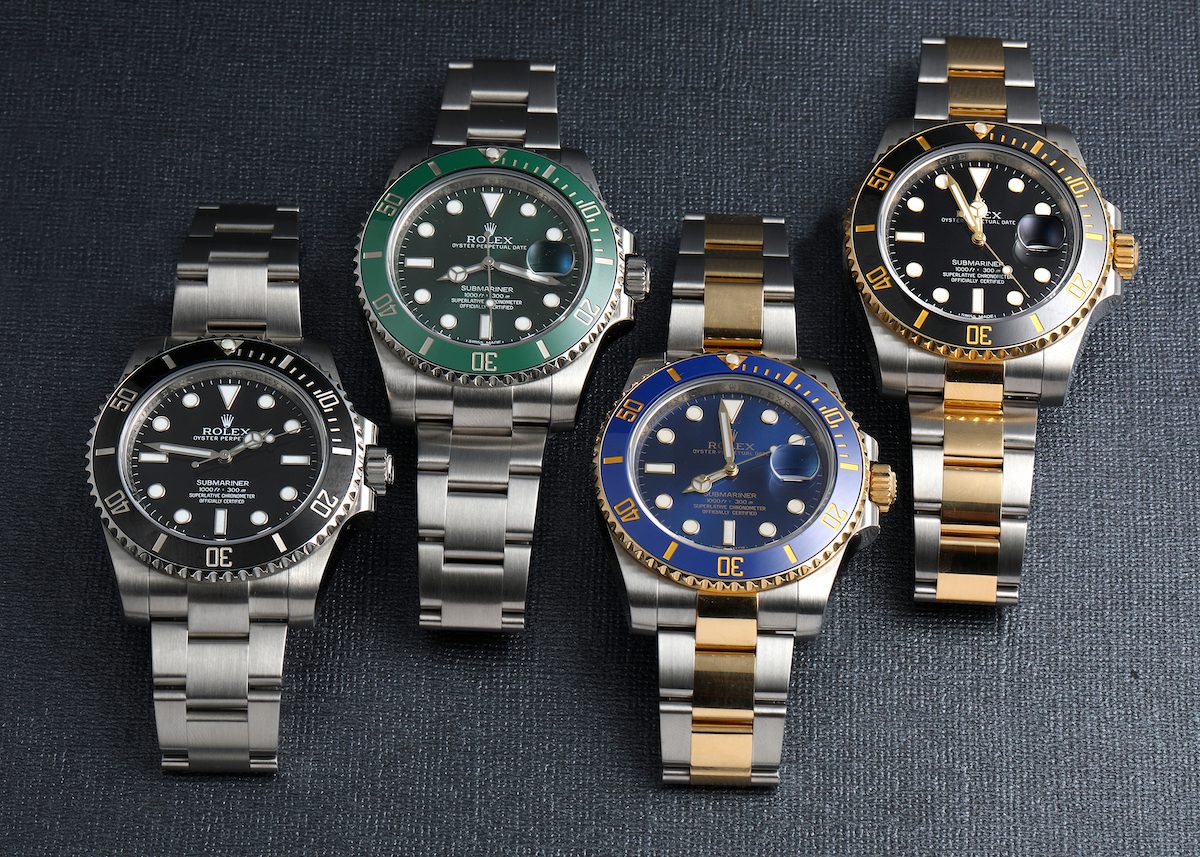 Rolex Submariners with Ceramic Bezels
Rolex Submariners with Ceramic Bezels
WATERPROOF OYSTER CASE
Invented by Rolex in 1926, the Oyster case was the world’s first waterproof wristwatch case. This feat is thanks to Rolex’s patented system of hermetically screwing the winding crown, bezel and case back directly against the middle case.
The Rolex Submariner’s Oyster case is composed of a screw-down caseback and a screw-down Triplock winding crown that keeps dust and moisture out. The triple waterproofness system is designed to protect the watch not just from moisture, but also from dust, pressure, and shocks.
Today’s Rolex Oyster case comes in a variety of metals, including stainless steel, steel and yellow gold (Rolesor), 18k yellow gold, and 18k white gold.
The Rolex Submariner case was initially 37mm, and became 40mm in 1959. It would stay that way for the next 60 years, and 40mm would be considered the standard size for Rolex sport watches. In 2020, for the very first time, Rolex increased the Submariner’s case, so the current collection now measures 41mm.
Rolex Submariners with Ceramic Bezels
60-MINUTE BEZEL
The Rolex Submariner bezel has always featured 60-minute graduations and a distinct arrow marker at the 12 o’clock position. These graduations are meant to help the wearer to accurately monitor their time underwater. The first Rolex Submariner models featured a bi-directional rotating bezel.
The patent for the unidirectional rotating bezel was owned by Blancpain, makers of the Fifty Fathoms dive watch, until 1983, so every Submariner had bezels that turned both ways until then.
The bezels were later improved into unidirectional bezels that can only move forward. This proved helpful in avoiding the overestimation of immersion time.
Why is a unidirectional bezel important for dive watches? If the bezel is knocked underwater, a unidirectional bezel would only move forward, and display a longer underwater time. This means that the wearer will overestimate his time underwater, rather than underestimate it and stay longer. This keeps divers from suffering the effects of decompression sickness.
LUMINOUS MARKERS
When diving, being able to read the time with absolute certainty is non-negotiable. To achieve this, dive watches are always equipped with luminous markers and hands, which makes time easily readable even under murky waters.
The first type of luminescence used on the Rolex Submariner was radium. It remained the standard luminous material for Rolex until 1963, but was phased out when the toxic effects of radium became more understood. It was then replaced by tritium.
Rolex has used five different types of luminescence: Radium, Tritium, Luminova, Super-Luminova and Chromalight. In photo: Rolex Kermit II or Starbucks, and Rolex Hulk
While tritium is safer than radium, it was still radioactive, so Rolex indicated the level of radioactivity emitted by the watch on its dial. These are indicated by the text “T Swiss T”, or “Swiss T<25” at six o’clock.
Rolex continued its search for safe luminous materials, but the answer would not come until 1998, when Japanese company called Nemoto and Co., which specialized in luminous paint, introduced the Luminova. The new material was photoluminescent rather than radioactive, making it completely safe for use. Moreover, its glow is charged by being exposed to light, making it less prone to fading compared to tritium.
In the 2000s, Rolex quickly upgraded to the Super-Luminova, a Swiss-made version of the Luminova.
In 2008, Rolex introduced their proprietary lume called Chromalight. According to Rolex, it has longer glow compared to Super-Luminova (up to eight hours to be exact), and it also glows blue in the dark, making it easier to read in low-light situations.
OYSTER BRACELET
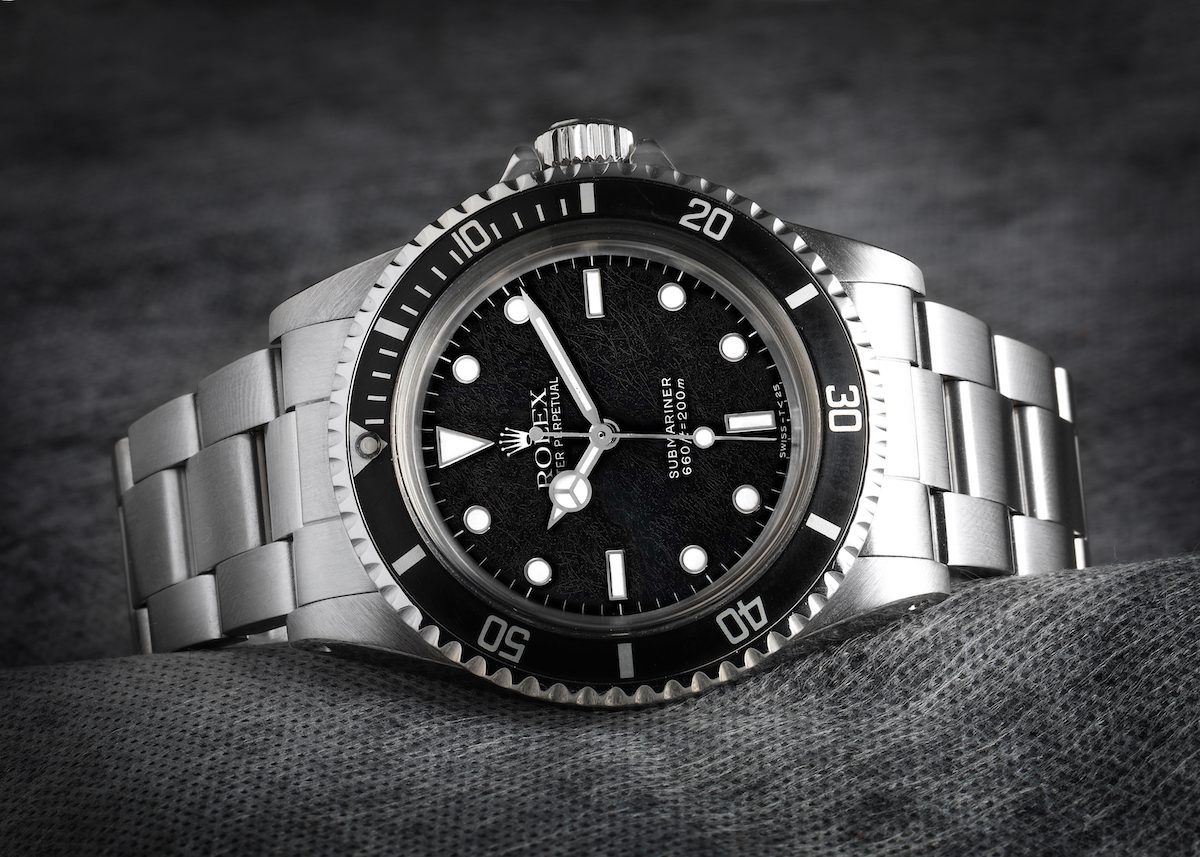
The Rolex Submariner is always paired with the Oyster bracelet.
In photo: Rolex Submariner Vintage Steel Watch 5513
The Rolex Submariner has always been equipped with the three-link Oyster bracelet since its inception. The Oyster is considered the sportiest of all Rolex bracelets, and is used on the entire Professional line.
The Oyster bracelet used on the Submariner is paired with the Oysterlock safety clasp, which secures the bracelet onto the wrist and prevents accidental opening.
In the 2010s, Rolex Submariners were updated with the Glidelock extension system, which allows the wearer to extend the bracelet in 2mm increments, for a total extension of up to 20mm. This feature allows for the watch to be worn comfortably over a wetsuit.
Generations of the Rolex Submariner
In true Rolex fashion, the Submariner has only been slowly and gently revised since its launch 70 years ago. Despite the decades-long gap between each generation, they can still be easily recognized as Rolex Submariners – a testament to its timeless design.
Rolex has made subtle but significant improvements in the Submariner’s materials and technology over the decades. Below, we trace the evolution of the Rolex Submariner and the introduction of key features to the collection:
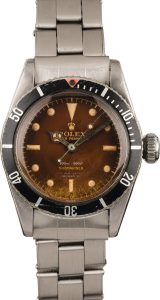
Rolex Submariner ref 6538 “James Bond” (photo: Sotheby’s)
37MM CASES WITHOUT CROWN GUARDS (1953 – 1962)
Reference Numbers: 6204, 6205, 6200, 6536, 6536/1, 6538, 5508 and 5510
The earliest Rolex Submariners were made of stainless steel cases measuring 37mm. In the first five years of the Submariner, Rolex was constantly improving on the design, resulting in a total of 8 models in a short span of time.
These models can have either 100-meter or 200-meter water resistance, pencil-style hands or the now standard Mercedes handset, and different crown sizes ranging from 5.3 to 7mm Small Crowns or the 8mm Brevet “Big Crown”. All these models feature gilt dials with golden texts, acrylic crystals, and bidirectional rotating aluminum bezels.
During this time, Rolex was still experimenting heavily with the new watch, hence they released version after version of the Submariner, a number of which were available concurrently. Doing so paid off as it clearly helped the Submariner find its footing.
Below are the production dates for each reference:
ref 6204 – 1953 to 1955
ref 6200 – 1952 to 1954
ref 6205 – 1953 to 1955
ref 6536 – 1955 to 1959
ref 6538 – 1956 to 1959
ref 6536 – 1954 to 1958
ref 5508 – 1958 to 1965
ref 5510 – 1959
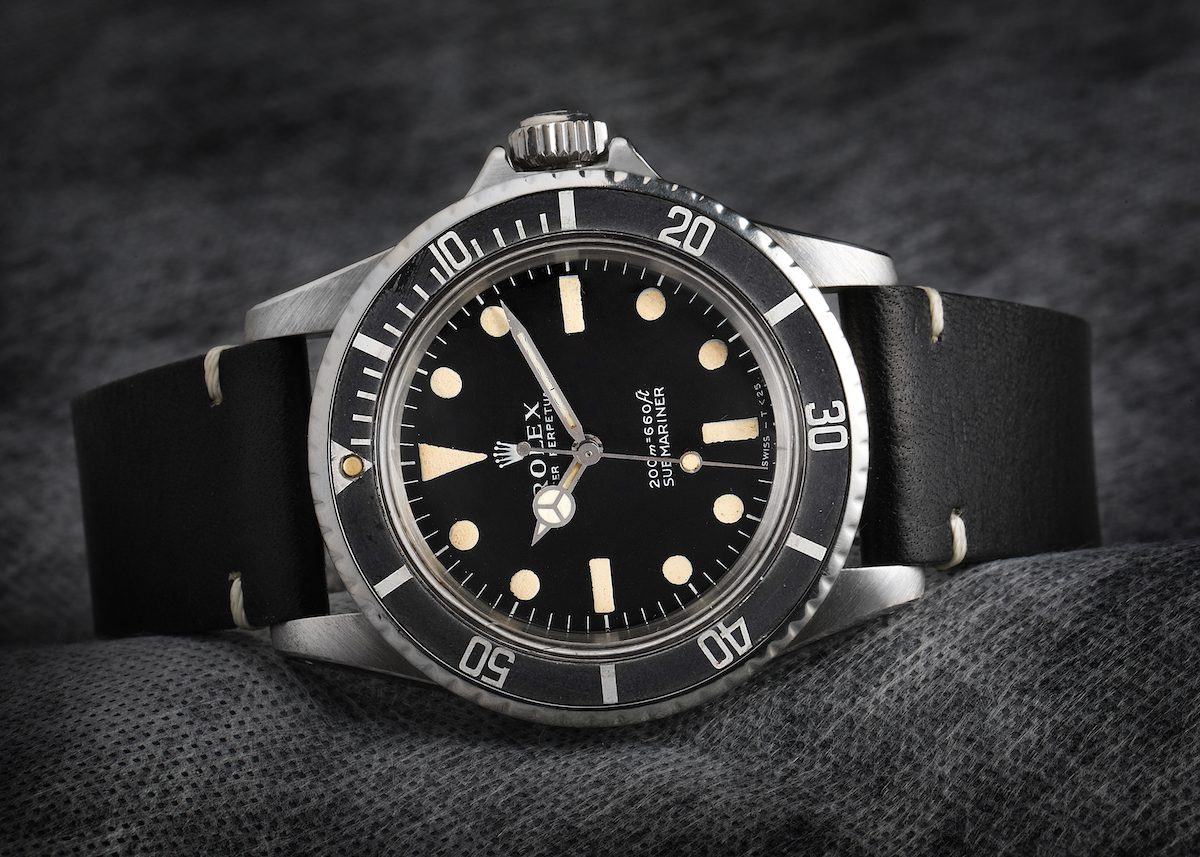
Rolex Submariner Vintage Steel Watch ref 5513
40MM CASES AND CROWN GUARDS (1959 – 1989)
Reference Numbers: 5512 and 5513
This generation of the Rolex Submariner embodies the design that we know today. The reference 5512 has the 40mm wide case, beveled lugs, crown guards, 7mm crown, demarcated dive bezel, text at 12 and six o’clock, the 200m depth rating, and the standard Mercedes hands. Rolex introduced the crown guards to keep the winding crown from going loose.
These two references were produced for a very long time (the ref 5512 until 1980, and the ref 5513 until 1989), which saw a number of design changes. Among them was the change from radium luminescence to tritium in the mid-1960s, and variations of matte dials with black text and gilt gloss dials. The main difference between the 5512 and 5513 references is that versions of the 5512 became COSC certified.
Below are the production dates for each reference:
ref 5512 – 1959 to 1978
ref 5513 – 1962 to 1990
Rolex Submariner Vintage Black Mark V Dial Steel Mens Watch 1680
INTRODUCTION OF THE DATE APERTURE (1969 – 1979)
Reference Numbers: 1680
The Rolex Submariner ref 1680 marked the introduction of the date complication at 3 o’clock. In addition to the date, it also featured the magnifying Cyclops window on the case. The earliest iterations of the 1680 also featured red Submariner writing on the dial, earning it the nickname “Red Submariner”. By 1977, Rolex changed the Submariner writing to white.
INTRODUCTION OF PRECIOUS METALS (1969 – 1979)
Reference Numbers: 1680/8
The Rolex Submariner ref 1680/8 was the first Submariner to come in solid 18k gold. This signaled the Submariner’s evolution from a tool watch to a robust luxury watch. The first 1680/8 model came with a black aluminum bezel and dial, and eventually a blue version was also introduced. These feature ‘nipple’ dial markers with slightly protruding shapes.
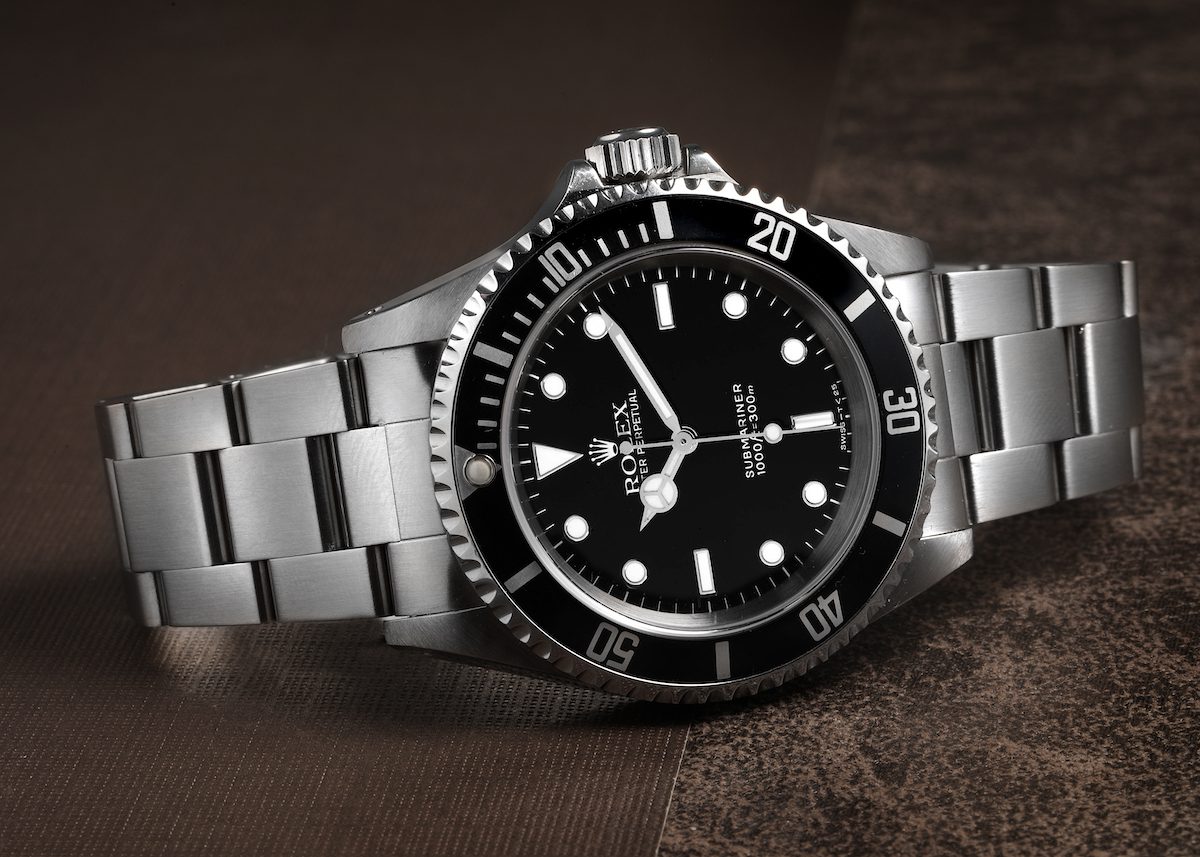
Rolex Submariner 40mm Non-Date 2 Liner Steel Mens Watch 14060
INTRODUCTION OF SAPPHIRE CRYSTAL & UNIDIRECTIONAL BEZEL, WATER RESISTANT TO 300M (1979-1999)
Reference Numbers: 16800, 168000, 14060 (1979-1988) and 14060 (1990-1999)
The Rolex Submariner 168xx references introduced three design elements that we still see in the collection today. First is the switch from acrylic crystal to scratch-resistant sapphire crystals. They also switched from bidirectional to unidirectional rotating bezels that can only rotate counter-clockwise, preventing any accidental manipulation underwater. Lastly, the Submariner’s water resistance was also improved to 300 meters (1,000 feet).
The 16803 was also the first Rolex Submariner to come in a Rolesor variant, or a combination of stainless steel and 18k yellow gold.
The no-date Rolex Submariner 14060 was the last reference to receive the sapphire crystal, unidirectional rotating bezel, and 300m water resistance when it was launched in 1990.
Below are the production dates for each reference:
ref 16800 – 1977 to 1987
ref 168000 – 1987
ref 14060 and ref 14060M – 1989 to 2009
INTRODUCTION OF 904L STEEL (1988)
Reference Numbers: 168000
While it was only produced for a few months, the Rolex Submariner ref 168000 marked the introduction of 904L steel to the collection. Older Submariners were fashioned in industry standard 316L steel, but Rolex switched to 904L around 1985, because it takes a higher polish than other grades of steel and provides greater corrosion resistance.
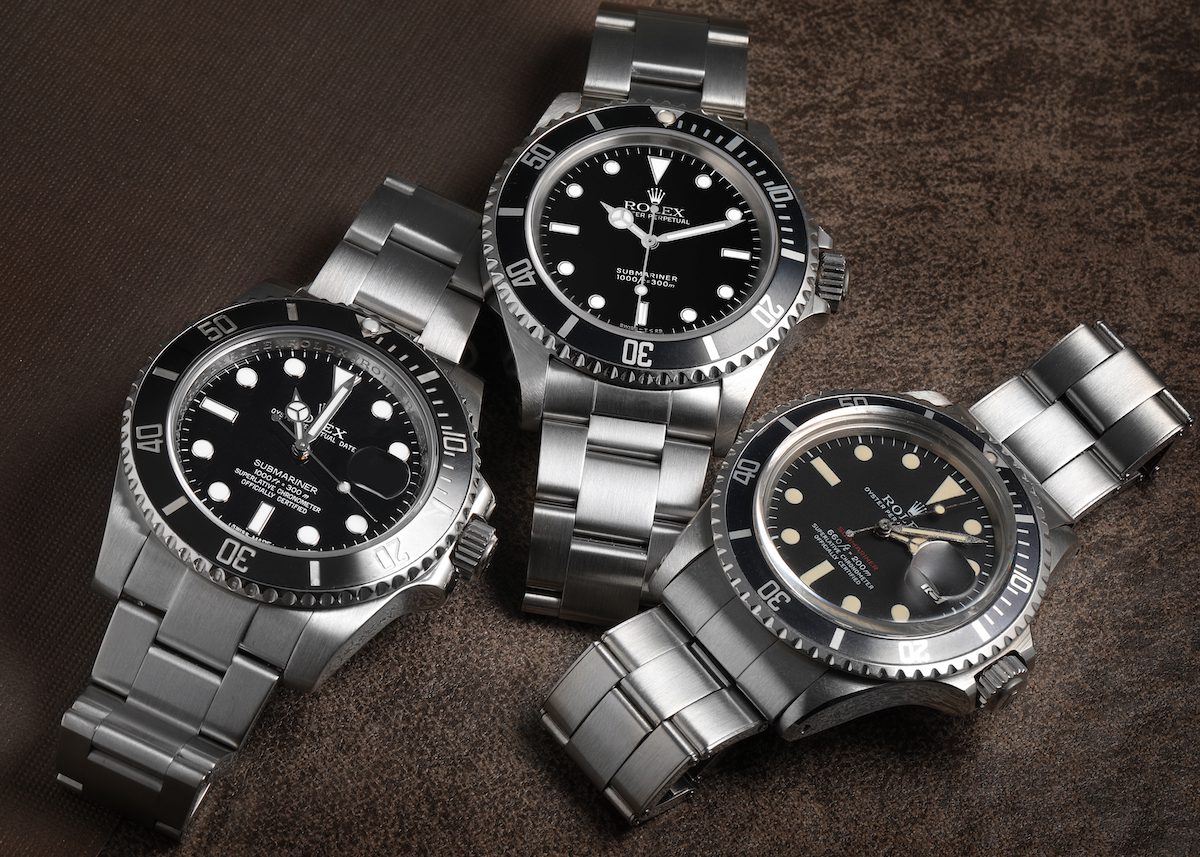
Different generations of the Rolex Submariner: ref 1680, ref 14060, and ref 116610
INTRODUCTION OF CALIBRE 313X (1988 – 2012)
Reference Numbers: 16610, 16618, 16613, 14060M
Rolex introduced the 3135 (date) and 3130 (no date) movements in 1988. These automatic movements are used in a large number of watches from Rolex and is now considered a base movement. They feature the Parachrom hairspring, which allows for greater resistance to shocks and temperature variations.
The 166xx series also marked the change from tritium markers to Luminova then Super-Luminova markers.
In 2003, Rolex also introduced the first green Submariner – the Rolex “Kermit”. This model commemorated the 50th anniversary of the Submariner model by introducing the first green aluminum bezel.
Below are the production dates for each reference:
ref 16610 – 1987 to 2010
ref 16610LV – 2003 to 2010
ref 16618 – 1990 to 2010
ref 16613 – 1988 to 2010
ref 14060 – 2007 to 2012
Rolex Submariner Steel Ceramic Bezel Watch ref 116610
INTRODUCTION OF CERACHROM CERAMIC BEZEL, SUPER CASE, & MAXI DIAL (2010 – 2020)
Reference Numbers: 116610, 116613, 116618, 116619, 114060
The six-digit Rolex Submariner references signal the introduction of the Maxi Dial, Super Case, and the Cerachrom ceramic bezel to the line. The case remained at 40mm but featured broader and squarer lugs, and wider crown guards that give it a beefier look. The bezel was also upgraded to Rolex’s patented Cerachrom ceramic insert, which offers greater resistance to scratching and fading.
In addition to these improvements, Rolex also introduced solid center links to reduce stretch, and a Glidelock extension system which allows the wearer to increase bracelet size up to 20mm without the use of tools.
In 2008, Rolex also introduced its first 18k white gold model. The grey-gold finish was paired with an all-blue Cerachrom bezel and glossy blue dial, earning it the nickname “Rolex Smurf” after the cartoon character.
All of these models were discontinued in 2020, following the Rolex Submariner redesign.
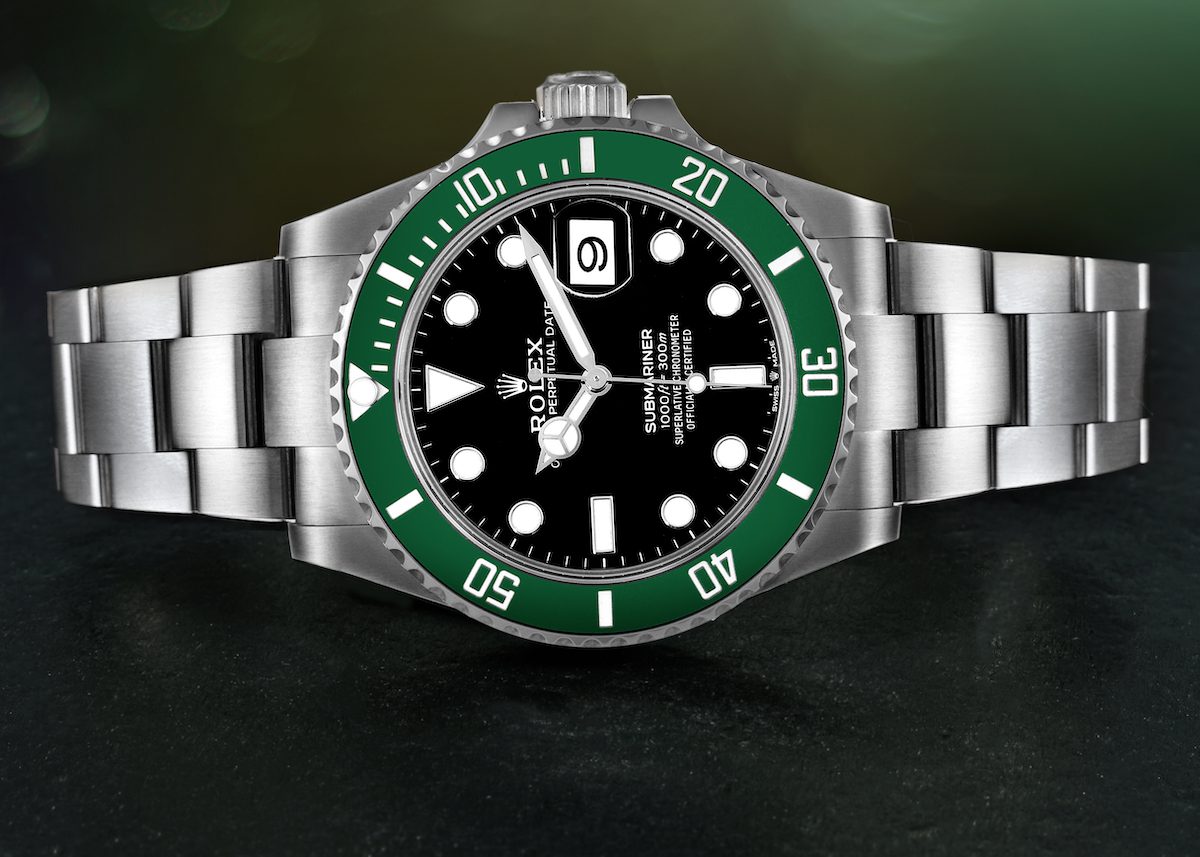
Rolex Submariner Green Ceramic Bezel ref 126610LV
INTRODUCTION OF 41MM OYSTER CASE & CALIBER 323X (2020)
Reference Numbers: 126610, 126613, 126618, 126619, 124060
In 2021, the Rolex Submariner line was updated all at once with a 41mm case. Despite the 1mm increase in case size, Rolex dropped the “Super Case” and instead featured longer and slimmer lugs, thinner crown guards, and an overall look that’s more similar to vintage Submariners.
They also feature the new generation in-house caliber 3230 (non-date) or 3235 (date). These movements result in increased power reserve of 70 hours (from 48 hours), and have been updated to a precision of -2/+2 seconds per day.
Rolex Submariner Terminology
Aside from their ever popular watch nicknames, Rolex watchmaking is rich in literature. Rolex has proven themselves masters in marketing with a slew of their own patented materials and terminology that set them apart and above the competition.
Here are some of the most common terms you’ll find within the Rolex Submariner family:
Crown: The winding mechanism found on the side of the watch, most commonly beside the 3 o’clock marker. Rolex has a screw-down crown design that holds the bezel, middle case, and caseback together to make the watch water-resistant. From its Oyster design from the 1920s, Rolex adapted it for use on the Submariner with the use of a gasket and receiving tube. The Twinlock System makes use of two O-rings to achieve water resistance, while the Triplock System has an additional O-ring. Thanks to this system, the water resistance rating for the Submariner increased from 100m to 300m in the 1970s, until today.
Crown Guards: Parts of the case that surround the winding crown on the right side of the case. Since crown guards protrude from the case, the guards protect them from shocks and impact that can accidentally unwind the crown. They were added to the Rolex Submariner in 1959.
Diving Bezel: While many sports watches have markings on their bezels, diving watches have specialized ones with 60-minute graduations, for use in timing bottom or decompression times. Earlier Rolex Submariner models had bi-directional rotating bezels until 1983, as Blancpain still owned the patent for unidirectional bezels. The unidirectional bezel only turns one way which keeps the diver from underestimating immersion time.
Rolex Submariner “Red” ref 1680 with Tritium Dial
Gilt Dial: A dial whose text, indices, and hour markers have been made in a golden color. These are the result of galvanization, which makes the gold-plated brass plate underneath the gloss to show through. These dials were used in the earliest Rolex Submariner models, until they switched to matte dials in the mid to late 1960s.
Matte Dial: A dial with a flat, greyish tone and with white text and Tritium-coated markers and indices. Rolex began using this dial type for the Submariner in 1966, and they give off a utilitarian look.
Glossy Dial: A dial with a glossy appearance, paired with white text and white gold surrounds on the luminous markers. The pairing gives the dial a more luxurious appearance. Rolex began using this type of dial on the Submariner in the 1980s, and continues to do so today.
Mercedes Hands: Handsets whose hour hand have a tip shaped like the Mercedes Benz logo. That they have the same shape is purely coincidental, Rolex used the three-way symbol as it holds a lot of luminous paint. They began using this on the Submariner in the mid-1950s.
Pencil Hands: Slim, arrow-tipped hands used by Rolex before they switched to the Mercedes-type hands.
Oyster Bracelet: A bracelet with three-piece links, and the sportiest of Rolex’s bracelet designs. The design originated from Gay Frères-made bracelets sourced by Rolex in the 1930s. The company patented it in the 1940s.
Rolex Submariner “Hulk” 116610LV featuring a Super Case and Maxi Dial
Maxi Dial: A dial with larger lume plots, and hour and minute hands, for improved legibility. These first appeared on the reference 16610LV “Kermit” Submariner.
Super Case: A modern generation of cases that feature broader and fatter lugs, a wider bezel, and a thicker profile. Rolex first used these in the GMT-Master II in 2005, and introduced it to the Submariner line in 2008.
Easylink Extension: A patented bracelet system that allows the wearer to extend the length of the Oyster bracelet by 5mm without having to use tools. This is particularly useful when wearing the watch over a wetsuit, or to accommodate a larger wrist during warmer weather.
Glidelock Clasp: Rolex’s most advanced clasp system, which allows the wearer to expand the band by 20mm, in 2mm increments. This is exclusively found in Rolex dive watches (to include the Sea-Dweller and the Deepsea) and first appeared in the Submariner in the 2010s.
Twinlock and Triplock Winding Crown: Rolex’s patented sealing systems formed by a threaded screw-in crown and rubber gaskets that make the watch water tight. A Twinlock crown has two sealed zones and is used for watches with water resistance of 100 meters / 300 feet. The Triplock crown has three sealed zones and offers water resistance up to 300 meters / 1000 feet.
Popular Rolex Submariner Models
There is a wide range of Rolex Submariner models to suit every taste, with various materials, and dial and bezel colors available. Here are the most sought after of them all:
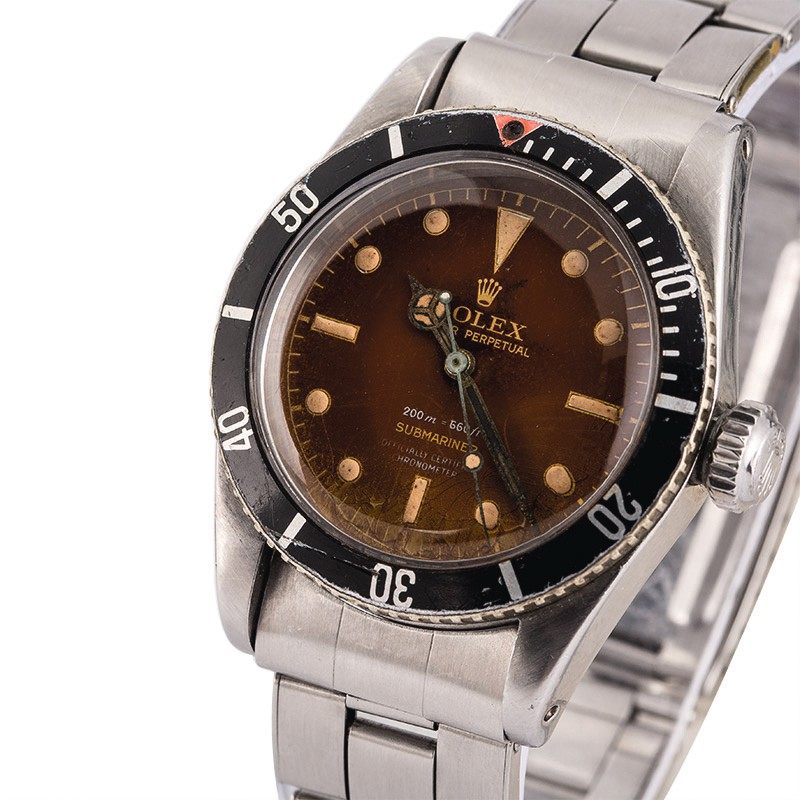
Rolex Submariner ref 6538 (photo: Sotheby’s)
Rolex Submariner “James Bond” ref 6538
James Bond famously wore Rolex Submariner watches from 1962 until 1989, but only one is called the “James Bond” watch – that would be the ref 6538 worn by Sean Connery in the first ever James Bond film, “Dr. No.”. The same watch accompanied Connery in succeeding James Bond films namely “From Russia with Love” (1963), “Goldfinger” (1964), and “Thunderball” (1965).
It is also called the “Big Crown” because it featured an 8mm size crown. Due to its illustrious history and the limited number of models produced, this model can fetch as high as six-digits in the auction block.
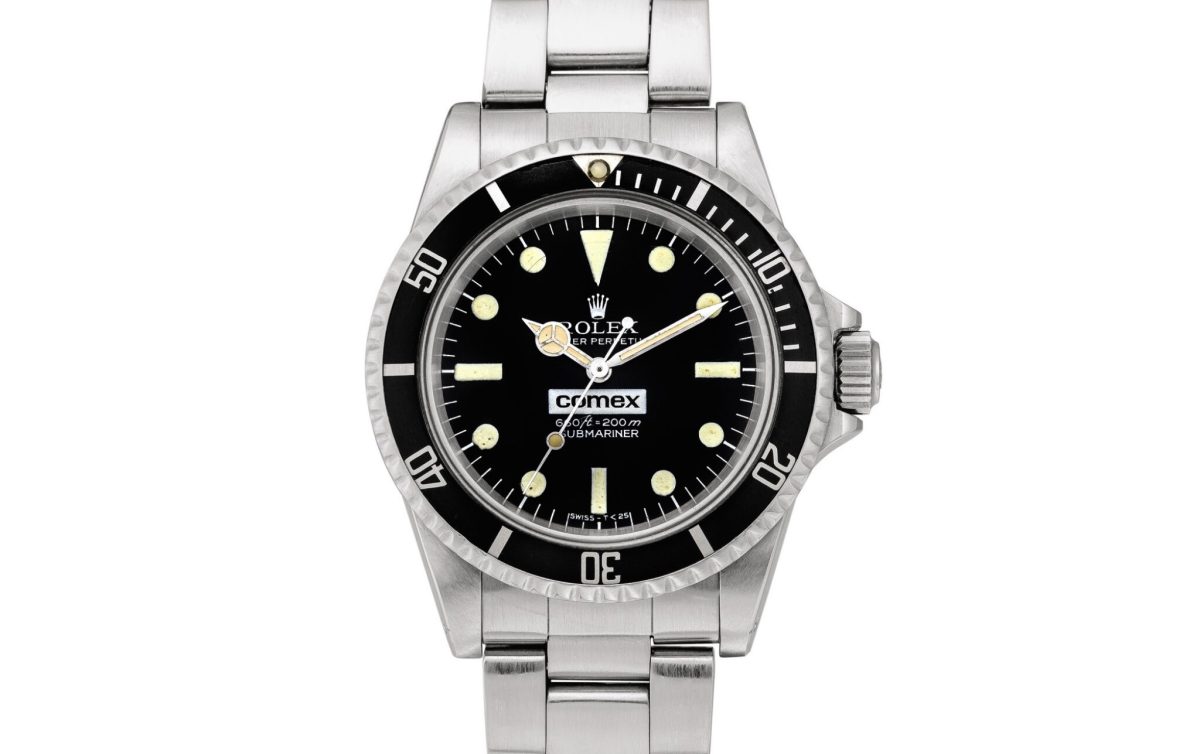
Rolex Submariner ref 5514 (photo: Sotheby’s)
Rolex Submariner “COMEX” ref 5514
From 1970 until 1997, Rolex worked with French diving company COMEX (Compagnie maritime d’expertises) to produce diving watches for their team. Rolex produced a total of nine watches for COMEX from both the Submariner and Sea-Dweller collections. These are easily recognizable with the COMEX text on their dials.
While Rolex produced both ref 5513 and 5514 COMEX models, it is the latter that is more sought-after, because it was produced exclusively for the French company. It is estimated that Rolex only produced 154 pieces of the ref 5514, and they can fetch as high as $200,000.
Rolex Submariner Steel Black Dial ref 16610, 116610 and 126610
Since its launch in 1953, the Submariner family has grown into many different designs and colors, but the most versatile one remains the stainless steel and black model.
The most recent versions of the steel and black Rolex Submariner are: the ref 16610 (produced from 1989 – 2010) which has an aluminum bezel; the ref 116610 (produced from 2010 – 2020) which features a Cerachrom bezel and a Super Case; and the latest 41mm version with a Cerachrom bezel, the ref 126610LN. These three appear very similar and are usually the top choices when choosing a stainless steel Submariner model.
The Aluminum bezel has a softer, matte and more toolish look that vintage Rolex fans like, but the disadvantage is that it can still be scratched or dented. The first Cerachrom ceramic bezel version (ref 116610) was unprecedented, because it is impervious to scratching and fading brought about by UV rays and chemicals. The current version (ref 126610) combines both worlds with a wider 41mm case, a Cerachrom bezel, but with a tapered profile that is reminiscent of vintage Rolex Submariner watches.
Rolex Submariner ref 14060 (photo: Sotheby’s)
Rolex Submariner No Date – ref 14060, 114060, and 124060
The No Date Submariner features a time-only dial, devoid of the usually-present date mechanism at 3 o’clock. These are available only in stainless steel and with black dials and bezels. Collectors prize them for the symmetrical look they offer, as well as their similarity with early Submariner models, specifically those made before 1969 when the date aperture was introduced to the Sub.
The most popular No Date Submariners are the modern 14060, the first No Date Sub with a sapphire crystal and Twinlock crown; and the 114060, which was updated with the Cerachrom ceramic bezel and Super Case.
Rolex Submariner Green Watches – Kermit 16610LV, Hulk 116610LV, and Starbucks 126610LV
Green watches are all the rage these days, and the Rolex Submariner was one of the first to use the unorthodox color. The very first green Rolex Submariner, the ref 16610LV “Kermit”, was released in Baselworld 2003 to celebrate the Submariner’s 50th anniversary. Rolex made small but significant tweaks to the classic steel Submariner to create this model – the most defining feature being its green aluminum bezel.
Throughout its seven-year production period, there were as many as nine different versions of the Rolex Kermit released.
While the Kermit introduced the green bezel to the Submariner line, the Hulk upped the ante with a matching green dial. First making an appearance in 2010, the Hulk’s green color is also more prominent. Furthermore, it was already equipped with the Cerachrom ceramic bezel, and comes with a heftier Super Case.
The original Kermit’s green and black colorway returned for the 2020 Submariner, this time with a 41mm case diameter. While the Kermit took on a bright, almost Kelly green tone, the new “Starbucks” Submariner has a deeper color and a more solid presence, especially when viewed from above. Not to mention it has a Cerachrom ceramic bezel insert and a new generation Caliber 3235 movement.
All in all, the Submariner has a wide range of green models to choose from.
Rolex Submariner Blue Dial Bezel “Smurf” ref 116619
While the Rolex Submariner was created as a tool watch, it has evolved into a luxury sports watch, with a still-reliable water resistance. Ultra-luxe versions of the Sub usually come in solid gold, with the 18k white gold version commanding a premium.
What sets the white gold Rolex Submariner apart from other white gold Rolex models is its “grey gold” finish, which gives it a darker appearance from typical white gold. This makes it easier to spot when placed alongside steel Rolex Submariners.
But it wasn’t just the precious metal of the case that got people talking. It featured a lacquered blue dial and Cerachrom bezel in a shade of blue never seen before on Rolex watches. This earned it the moniker “Smurf” among Rolex fans, based on the cartoon character.
Rolex Submariner Steel Yellow Gold Blue Dial “Bluesy” – ref 16803, 16613, and 116613
The blue dial and bezel Rolex Submariner became popular in the 1970s, but since it was offered only in solid 18k gold versions, its price did not make it accessible to a decent number of Rolex fans. This changed in 1984 when Rolex introduced the first two-tone, steel and 18k yellow gold Rolex Submariner (ref 16803). It was offered with either a blue or black dial and matching bezel.
The more affordable and understated combination of hardy stainless steel and luxurious yellow gold made blue Submariner watches available to a wider audience, and it remains one of the most popular Rolex Submariner designs today. It’s an excellent middle ground for those who want a dressier dive watch for all-occasion use, but find gold models too flashy.
There have been several variations of the two-tone blue Submariner produced throughout the years – ref 16803, 16613, and 116613 which already has the Cerachrom bezel. Regardless of the specific reference, two-tone Rolex Submariners with a blue dial and bezel are nicknamed “Bluesy”.
Common Questions About the Rolex Submariner
The Rolex Submariner is the most famous dive watch of all time, and one of Rolex’s best-selling models. Here are answers to the most commonly asked questions about the Rolex Submariner.
What is a Rolex Submariner?
The Rolex Submariner is a line of diver’s watches from Rolex, introduced in 1953. The Submariner is characterized by a waterproof Oyster case, a self-winding Perpetual movement, a unidirectional rotating bezel with 60-minute graduations, and a water resistance of 300m (1,000 ft).
How can I tell if my Rolex Submariner is real?
Due to its fame and great demand, the Rolex Submariner is a hot target for counterfeiters. All Rolex watches are made with the highest standards and top quality materials, so poor construction is a dead giveaway.
Before you purchase your Rolex Submariner, it is essential to do research on your chosen reference, and to familiarize yourself with its most minute details, so you can more easily spot a fake. The best defense against buying a fake Rolex Submariner, or any fake timepiece, is to buy from a reputable dealer, like SwissWatchExpo, who can provide a guarantee of authenticity on the watch.
Rolex Submariner watches can be worn by both men and women.
How much is a Rolex Submariner watch?
The price of a Rolex Submariner watch depends on several factors:
Where it was purchased – Authorized dealers sell the watches at prices published by Rolex. However, getting your Rolex Submariner is not as easy as walking into the store and buying one. With demand currently outpacing supply, it is unlikely that a Submariner is in stock at your AD – the more likely scenario is that you will be invited to join a years-long wait list.
As of 2023, current production Rolex Submariners retail from $9,100 starting with the steel No-Date model, and up to $42,000 for the most expensive of the bunch, the 18k white gold model.
On the secondary market, you can browse through a wider assortment of Rolex Submariner watches – from previous and current productions to vintage and unworn models. Given that the secondary market offers hundreds of variations from almost seven decades of the Submariner’s history, the prices of a used model can vary greatly from four to six figures.
Materials, production year, and condition – Prices for Rolex Submariners vary substantially depending on the following characteristics:
Reference number
Material type (steel, two tone or solid gold)
Age and condition
In general, prices are lowest for stainless steel models, followed by two-tone, or stainless steel and gold models. The most expensive Submariners are those made of solid 18k yellow gold and white gold.
History – While the model and reference number significantly determine the price of a Rolex, there are models that are exceptions to the rule. Collectible models such as green bezel Submariners (Hulk and Kermit), vintage models associated with pop culture (such as James Bond watches) or rare milestone models (such as the Red Submariner) fetch higher prices than their counterparts.
Why did the James Bond franchise stop using Rolex Submariner?
The very first James Bond, played by Sean Connery, wore a Rolex Submariner ref 6538 in four of the Bond films he starred in. In succeeding movies, Bond was seen wearing brands like Rolex, Gruen, Seiko, and Tag Heuer – but the most prominent his timepieces was still the Submariner.
In 1995, the Omega Seamaster appeared on the wrist of Pierce Brosnan in GoldenEye, signalling the start of Omega’s exclusive partnership with the Bond film franchise. Bond has been wearing Omega Seamaster watches since then.
Omega has been known to manufacture special watches for the film, and release limited editions sold to the public in anticipation of the upcoming Bond film. The relationship continues to this day, with the latest James Bond, actor Daniel Craig, sporting a titanium Omega Seamaster in No Time To Die (2021).
Rolex Submariner Vintage Spider Net Dial Steel Mens Watch 5513
Why are Rolex Submariners expensive?
The price of every Rolex watch is determined by their in-house development costs. Rolex only uses the finest raw materials (such as their own gold alloys and 904L steel), utilize groundbreaking tools and equipment, and always come up with new techniques to stay ahead of the competition. As such, their timepieces are priced accordingly.
The Rolex Submariner is also in high demand in the pre-owned market, and this appetite for the Submariner drives the costs up.
How do I wind a Rolex Submariner?
Rolex Submariner models have screw-down crowns. This means that in order to wind the watch and set the time, it would first have to be unscrewed from the case. To unscrew the crown, rotate it towards you (counter clockwise) until it pops out of its position and is free from the threads that secure it onto the case.
To wind the watch manually, turn the crown away from you (clockwise). Rolex Submariners do not have natural stopping points due to their automatic winding movements. Continue winding until 40 rotations and the watch will be fully wound.
Buying New vs Pre-Owned Rolex Submariner Watches
When buying a timepiece, one of the questions that follow after deciding on a model is whether you should buy it brand new or pre-owned. One huge benefit of buying from the Authorized Dealer is that you know you are getting the real thing. However, popular watches, especially steel sports watches such as the Rolex Submariner, are very hard to come by at authorized dealers, and usually entail years of waiting. This is where the secondary market comes in. Aside from having your watch more readily available, buying a watch pre-owned offers various benefits.
Watches are quite similar to cars in a sense that watches can only be sold as “brand new” once by an authorized dealer. Once your watch leaves the dealership, it is already considered pre-owned, whether or not it was worn after that. Consequently, there will be a certain level of depreciation when the item moves from “brand new” to “pre-owned”.
Rolex Submariner Steel 18K Yellow Gold Black Diamond Dial Watch 116613
When you buy a watch pre-owned, you avoid taking this initial depreciation. The person who bought it brand new has already taken this hit for you. In general, a pre-owned Rolex watch will be less expensive than a brand new piece.
We have to clarify that this is not always the case. Specifically, older Submariner models can be bought as comparative bargains, but there are older and vintage models that soar in value over the years due to their history and collectability.
Buying your Rolex from the pre-owned market also opens up a wider range of models and price points. Authorized dealers only carry current production models, whereas in the pre-owned market, you have a vast array of models to choose from – including previous versions of watches, limited editions, and even current production models that have been resold.
Lastly, pre-owned watches are not always old – they can also be bought in mint and excellent condition. There are instances where watches have been kept unworn and stored after purchase. If the watch has been worn and used for years, it can still be in great condition if it was sent for maintenance regularly.
At SwissWatchExpo, we are committed to delivering watches in “like new” condition, so every watch that we offer for sale is first inspected, and restored if needed, by our trained watchmakers. Such restorations are standard in the industry, and we often hear from clients that they can’t believe the watch isn’t new! By choosing to buy your Rolex Submariner pre-owned, you not only have the chance to save up to thousands from the retail price, you can also get your watch much earlier, and have more models to choose from.
<>
With its ruggedly handsome design, the Rolex Submariner proved to be equally at home out of the water, and has since evolved into an iconic all-occasion timepiece. Explore our collection of Rolex Submariner watches at SwissWatchExpo.com.

